Page Index
Background and History
It all started with SuperBASIC …
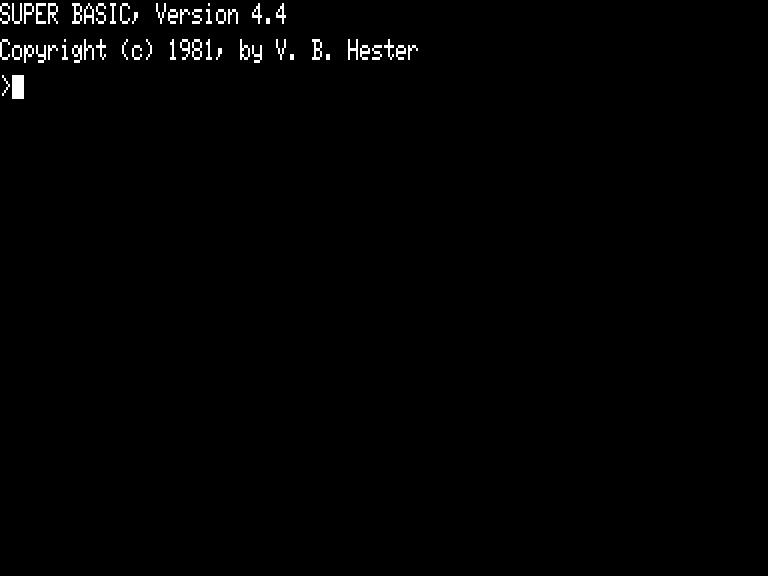
SuperBASIC
SuperBASIC was a re-modified version of Microsoft’s BASIC as modified by Apparat (NEWDOS). SuperBASIC started with version 3.0 because Microsoft’s BASIC for TRSDOS was at version 2.1. SuperBASIC 3.0 used ROM calls that were not in Microsoft’s version (despite the fact that Microsoft wrote the ROM); and, had ALL new code for the 28 Disk BASIC links. In addition, Vernon added CMD”O” – open an additional file buffer area keeping variables intact (this was dropped in MULTIDOS), CMD”X” – transfer the resident BASIC program to LEVEL II (this was later changed to CMD”W” in MULTIDOS), BASIC program chaining (NAME for Model I/III and CHAIN for MAX-80/Model 4), and a much faster CMD “doscommand” (no checksum was performed because SuperBASIC updated TOPMEM [4049H]). {by the way, Apparat STILL did not update TOPMEM with NEWDOS80/2}. Vernon just gave away SuperBASIC 3.0 for free and the owner of Level IV Products, Chuck (Virgil) Cheseldine, heard about SuperBASIC. Chuck and Vernon talked (about May 1980) and he suggested that Level IV Products should sell SuperBASIC 3.0.
… but what Operating System will run it? ULTRADOS …
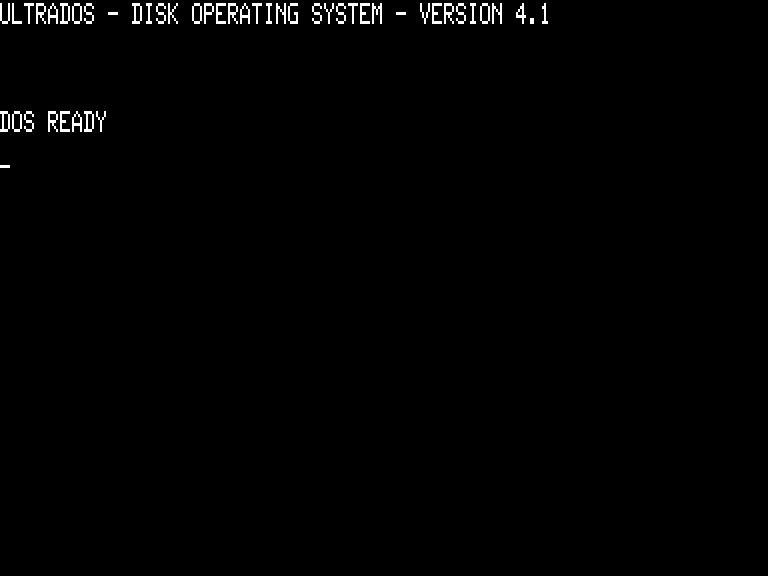
UltraDOS 4.1
At that time TRSDOS was up to version 2.3, NEWDOS/80 for the Model I was coming; and, to ensure Chuck and Vernon had a ‘foundation’ to sell SuperBASIC, Chuck suggested that Vernon make a DOS. Yikes!! The initial name was Level IV DOS, and Vernon did the same thing Apparat did in acknowledging Randy Cook as the author of specific DOS modules (i.e., SYS0/SYS, SYS1/SYS, etc). Chuck had concerns about the Randy Cook acknowledgement. So, Vernon only slept for about 4 hours a night for a month redoing all of the /SYS modules. And, ULTRADOS 4.1 was introduced September 1980 in Chicago at a Computer Fair. Vernon cannot remember why the name was changed to ULTRADOS – and the 4 is just the Arabic version of ‘IV’. ULTRADOS was updated twice – October 1980 and March 1981. Vernon did not get a commission for ULTRADOS sales but did get promoted to Vice President.
… and let’s make that interoperable! MultiDOS …
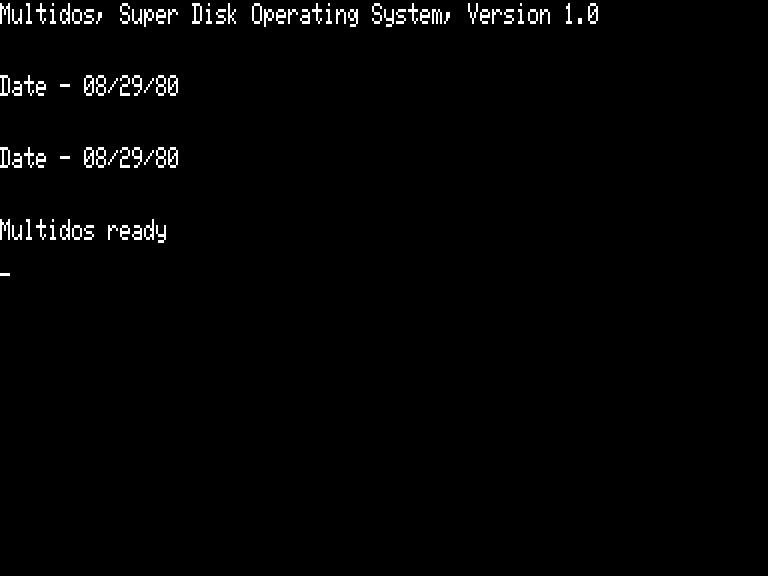
MultiDOS v1.0
Kim Watt (Berkley, MI) and Vernon started collaborating on new software ideas in early 1981. Chuck raised some concerns about that, so Vernon told Kim to forget it. Later Vernon regretted parting ways with Kim. Kim had this idea (in 1981!!) to created a method for spreadsheets, word processors, and database management software to be able to communicate among themselves (based on what Vernon can remember, Microsoft Office 95 finally did that). Vernon’s regret grew (into anger) over time and in April 1981, he gave up his Vice Presidency, and started a double-density version of ULTRADOS (ULTRA-II). The first ad hit 80-Micro in Autumn 1981 as ULTRA-II, and after subsequent discussions among people, Vernon changed the name to MULTIDOS as suggested by Charlie Butler (Alternate Source).
MULTIDOS is the only TRS 80 disk operating system (DOS) developed that uses a similar format in communicating among the TRS 80 MODEL I, MODEL III, MODEL 4, and the LOBO MAX-80, i.e., some machine language programs and most BASIC programs will run under MULTIDOS in all four machines. BASIC programs that contain PEEK, POKE, USR, CMD, CLOAD, and CSAVE will probably have to be changed.
MULTIDOS went on sale in 1981, and continued to be sold by Vernon until 1984 when Vernon became an author and AlphaBit Communications, Inc. (Dave Welsh) became the publisher. In 1987 Vernon upgraded MULTIDOS from version 2.0 to 3.0 extending the maximum system date from 1987 to 2043. AlphaBit informed Vernon that LS-DOS had a different date scheme and “requested” that Vernon use LD-DOS’s date scheme; therefore, MULTIDOS was (retro)grated, released 1 October 1987, to version 2.1 for the Model I, Model III, MAX-80, and Model 4. Similar to LS-DOS, MULTIDOS version 2.1 extended the maximum system date from 1987 to 2011.
AlphaBit sold MULTIDOS from 1984 through ???. Sometime in the early nineties, Computer News 80 informed Vernon that AlphaBit was telling people interested in MULTIDOS to forget the Model 4 and migrate to the IBM PC family of computers. Vernon permitted CN80 to sell MULTIDOS sometime in 1994. [CN80 was already publishing ASTROCAL since 1991. ASTROCAL was supplied on a combination DOS that booted in a Model I or Model III or Model 4.] CN80 was only interested in the Model 4 version; therefore, (being a little arrogant) Vernon sent CN80 Model 4 MULTIDOS version 3.0 (date to 2043). Any upgrades to the Model I and Model III versions of MULTIDOS were strictly ‘internal’ i.e., just Vernon.
… and let’s free up more RAM! ESOTERIC.
In June 1998 Vernon decided he wanted to take advantage of a different Model 4 memory map which would afford 2048 more free bytes for applications, so he developed ESOTERIC.
OK … but did Vernon make any other DOS’s?
Glad you asked! In November of 1982, Vernon also wrote Z’DOS which was simply an attempt to get people into something other than TRSDOS at a reasonable cost. Z’DOS was never updated and three versions were created: Model I Single-Density, Model I Double-Density, and Model III.
UltraDOS to MultiDOS Transition
Filename
ULTRADOS
MULTIDOS
Remarks
BACKUP/CMD
no
yes
new file for diskette copy, includes formatting diskette
BASIC/CMD
yes
yes
changed syntax for hex/octal constants: H optional
BASICS/CMD
yes
no
not considered necessary for MULTIDOS
BASICT/CMD
yes
no
not considered necessary for MULTIDOS
BBASIC/CMD
no
yes
new file: SuperBASIC with BOSS
BC/CMD
yes
no
Moved into DOS0/SYS
CHAIN/BAS
yes
no
not considered necessary for MULTIDOS
CHAIN1/BAS
yes
no
not considered necessary for MULTIDOS
CHAIN2/BAS
yes
no
not considered necessary for MULTIDOS
CO/CMD
yes
no
Moved into DOS6/SYS
COPY/CMD
yes
yes
changed to single file copy
DA/CMD
yes
yes
Slightly modified version of Apparat’s DISASSEM/CMD. Level 4 wanted it in ULTRADOS to be considered competitive. Vernon considered it inappropriate to include in MultiDOS.
LM/CMD
yes
yes
Slightly modified version of Apparat’s LMOFFSET/CMD. Level 4 wanted it in ULTRADOS to be considered competitive. Vernon considered it inappropriate to include in MultiDOS.
SYS00/SYS
yes
DOS/SYS
Rewritten to handle double density, FORMS, LC, and BC.
DOS0/SYS
no
DOS0/SYS
New overlay to reduce footprint of DOS/SYS
DOS7/SYS
no
DOS7/SYS
new file: Minidos: ‘Mighty Multi (C=COPY, D=DIR, K=KILL, L=LIST)’
SYSFE/SYS
yes
no
merged with DOS/SYS
UZ/BAS
yes
no
insufficient time to develop for MULTIDOS
DOS Feature Comparison Chart (January 1982)
Feature
MULTIDOS
DOSPLUS
LDOS
NEWDOS/80
TRSDOS
Repeat last DOS command
Yes
No
No
No
No
Multiple DOS command
Yes
No
No
No
No
APPEND checks LRL
Yes
No
Yes
No
No
Invincible AUTO
Yes
No
No
SYS opt
No
Alphabetized DIR
Yes
No
No
No
No
Read any format inc NEWDOS/80
Yes
No
No
No
No
Single-step BASIC program
Yes
No
No
Yes
No
Delete arrays
Yes
No
No
Yes
No
Used variables display
Yes
Yes
No
No
No
BASIC sort built in
Yes
No
No
Yes
No
BOOT at high speed
Yes
No
No
No
No
Nested DO’s
Yes
No
No
Replaces
No
Capable of reading NEWDOS/80
Yes
No
No
Yes
No
One drive COPY
Yes
Limited
Yes
Yes
No
Menu driven multiple file copying
Yes
No
No
No
No
Blinking cursor
Yes
No
No
No
No
ATTRIB to level 7 (lockout)
Yes
No
No
Yes
No
MULTIDOS Version Number Scheme
MultiDOS was versioned numerically to 2 decimal places, which could then be followed by an uppercase letter, a lowercase letter, or both.
Uppercase Letters:
S
Single-Density Version (e.g, 1.6S)
D
Double-Density Version (e.g, 1.6D)
P
Pseudo-Density (Mixed Density) Version (e.g, 1.6P)
K
Kernel Versions which were used to distribute software (such as SuperDirectory by Computer Shack) (e.g, 1.6SK)
Lowercase Letters:
Lowercase letters simply meant a minor revision to the DOS (e.g., 1.6a, v1.6b, etc).
Both:
A version number of 1.6aS, would be major version 1.6, minor revision a, in Single Density.
Chronology
Date
Activity
Ver.
Comments
Total
Files
Files
Added
Files
Remv’d
Mar-1980
SuperBASIC
3.0
SuperBASIC 3.0 worked with TRSDOS2.1 or NEWDOS
Sep-1980
initial ULTRADOS
4.1
Single-Density, Model I operating system
Nov-1980
ULTRADOS
4.1
Added GR/CMD and VFU/CMD
Mar-1981
ULTRADOS
4.2
Added BC/CMD, CO/CMD, SPOOL/CMD and converted KN2/BAS and KNIFE/BAS into EDIT/SYS (global editor)
Sep-1981
MULTIDOS released
1.0
Single-Density, Model I operating system. Originally called ULTRA-II
23
Jan-1982
Model III MULTIDOS
1.0
Double-Density Model III operating system
23
Jan-1982
Model I fix
1.1
Fixed DOS0/SYS added HELP/CMD and SKIP/CMD
25
2
Apr-1982
Model I upgrade
1.3
Added CONVERT/CMD and PATCH/CMD
27
2
Apr-1982
Model I upgrade
1.4
HELP/CMD became DOS9/SYS. DOS6/SYS split into DOS6/SYS and DOS8/SYS. Added EA/DOC
29
3
1
May-1982
Model I upgrade
1.5
Added CAT/CMD and DBLFIX/CMD. Automatic recognition of Doublers
31
2
May-1982
New file
Added ZAP/CMD (finally!)
32
1
Sep-1982
Model I and Model III versions now in sync.
1.6
Largest seller. Format pattern selectable. Added DDT/CMD and TAPE/CMD. Merged TU/CMD into VFU/CMD. Deleted EA/CMD and EA/DOC. Model III went from 1.3 to 1.6 to match Model I. There is no Model III 1.4 & 1.5. Directory DAM changed.
31
2
3
Aug-1983
CEC Releases ZEUS
ZEUS/CMD sold separately
31
Dec-1983
MAX-80 MULTIDOS
1.7
CEC creates MAX-80 MULTIDOS. Incorporates drive control table
33
7
5
1984
1.7
Added drive control table for Model I and Model III. This removed FORMS code from resident DOS disappointing many customers.
33
Jan-1985
Model 4 MULTIDOS
1.7
CEC introduces Model 4 MULTIDOS – derived from MAX-80 MULTIDOS
34
2
1
Feb-1985
Updated All
1.71
To access NEWDOS/80 diskettes with GPL > 2, Added CDIR/CMD, FMAP/CMD, LO/CMD, MEMDISK/CMD, PRT/CMD, and SETCOM/CMD [Count BASIC/SEG]
39
6
1
Jun-1985
Humor NEWDOS/80
1.72
Enhanced MAX-80 and Model 4 SORT/BOL to do numeric sorting.
39
Jan-1986
Provide means to update Hard Disk Systems
2.00
Added T4/CMD, TWO/IDO, SPOOL/CMD, and SYSGEN/CMD. Side compare implemented. Enhanced CMD”V” to display array values, and enhanced SORT/BOL (MAX-80 & Model 4) to do multi-key/indirect sort.
43
4
Apr-1987
Needed to extend date beyond 1987
3.00
Introduced MULTIDOS 3.00 to handle dates beyond 1987 (internal). Added FIXDATE/CMD to convert dates and INSTALL/CMD to update hard disks to new date format.
45
2
Aug-1987
2.10
Incorporated TRSDOS 6 method for dates beyond 1987 (published)
45
Dec-1987
ASTROCAL
ASTROCAL/CMD initial “beta” version given to TRS-80 club members
45
1989
Added CP/CMD (now COMP/CMD) to compare two files.
46
1
Dec-1990
There are HD64180’s out there!
2.11
Modified many modules to remove undocumented Z-80 opcodes enabling MULTIDOS to work with XLR8er (HD64180 CPU). DIR now can OR wildcard masks and sort by size (Q) and/or extension (X). MAX-80 and Model 4 modified to handle editing of input.
46
Dec-1990
Backup large files
Added XCOPY/CMD (now PCOPY/CMD) to copy large files onto floppies.
47
1
Jul-1991
Save the screens
Added SS/CMD (now SSAVER/CMD) and support TIMCLOCK [3]
51
4
Aug-1991
Calculator
ASTROCAL/CMD published by CN80
51
Enhance XLRer
Added XMONITOR, XSYSRES/SYS, and XMEMDISK/CMD for XLR8er
54
3
Jul-1993
BASIC utility
Added UTIL2/BOL, support MegaMEM [2]
57
3
Apr-1994
Variable review
Added BASICV/CMD
58
1
Added MONITOR/CMD [2], SHOW/CMD, REMOVE/CMD (now MODULE/CMD), support BUS CLOCK [4], and ROM CLOCK [2]. ZAP “P” command (now “E”). ZEUS dates object code with latest date among resident and GET files.
68
10
Sep-1995
Support Hi-RES [2]
70
2
1996 and 1997
Major overhaul of MAX-80 and Model 4 BASIC (Date 3.00 – CN80)
70
Jun-1998
Started developing ESOTERIC (wanted to get the 2048 bytes for apps)
70
Oct-1998
Support Emulator clocks [4], added MRHARD/CMD
76
5
1988
For Model 4 and ESOTERIC: include 12 BASIC programs and 14 Hi-Res programs
102
26
Apr-1999
Model 4 ESOTERIC
1.0
First real ESOTERIC. Note: This is the complete system, DOS was ready 12/13/98
102
Jun-1999
Added CUSTOM/CMD. Converted CAT/CMD, CDIR/CMD, FMAP/CMD, and SPOOL/CMD to Library commands for MAX-80, Model 4, and ESOTERIC
99
1
4
Jul-2002
Eliminated BASICV (put features into standard BASIC)
98
1
2005
ASTROCAL/CMD [15] and ZEUS/CMD [2] now bundled with MULTIDOS
115
17
MULTIDOS Directory Records
Directory records are 32 bytes long in all DOSs except for Model III TRSDOS 1.3 (50 bytes). The differences between the directory records of MULTIDOS and LS-DOS are limited to bytes 0 – 2, and 16 – 19. The major difference between LS-DOS and MULTIDOS is the use of bytes to store the date and time. In LS-DOS the time is to the minute with a date range of 01/01/1980 through 12/31/2011. In MULTIDOS the time is to every other second (even) with a date range of 01/01/1980 through 12/31/2043.
The date format in LS-DOS kept the pre 1988 date format and used the bytes previously used by the access (user) password for the additional bytes required to extend the date to 12/31/2011 and the time to the minute.
The date format in MULTIDOS uses the pre 1988 date bytes for the access password, and uses the bytes previously used by the update and access passwords for the date and time.
Here is a summary of the date formats in the file primary directory entry:
Before file dating:
Bytes 1 & 2 were always zero, bytes 16 & 17 contained the hash code for the update password, and bytes 18 & 19 contained the hash code for the access password.
Initial file dating:
Byte 1 bits 3-0 are the month. Byte 2 bits 7-3 are the day, and bits 2-0 are the year offset by 1980.
Post 1987 dating:
Byte 1 bits 3-0 are the month. Byte 2 bits 7-3 are the day, and bits 2-0 are the year offset by 1980 (same as initial dating). Byte 18 bits 7-3 are the hour. Byte 18 bits 2-0 and byte 19 bits 7-5 are the minutes. Byte 19 bits 4-0 are the year offset by 1980.
MULTIDOS 3.x:
Byte 16 bits 6-1 are the year offset by 1980. Byte 16 bit 0 and byte 17 bits 7-5 are the month. Byte 17 bits 4-0 are the day. Byte 18 bits 7-3 are the hour. Byte 18 bits 2-0 and byte 19 bit 7-5 are the minute, and byte 19 bits 4-0 are the seconds divided by two.
Directory Record (DIREC) before files were dated:
00000000
000000000
updatePW
updatePW
accessPW
accessPW
DIREC initial file dating, LDOS & MULTIDOS 1.0 through 2.0:
xxxxMMMM
DDDDDYYY
updatePW
updatePW
accessPW
accessPW
DIREC post 1987 dating, LDOS/TRSDOS6 & MULTIDOS 2.1:
xxxxMMMM
DDDDDYYY
updatePW
updatePW
hhhhhmmm
mmmYYYYY
DIREC post 1987 dating, MULTIDOS 3.x or later:
accessPW
accessPW
xYYYYYYM
MMMDDDDD
hhhhhmmm
mmmsssss
From all the above, one can reasonably conclude from the differences that there needs to be a way to disable password checking. MULTIDOS never provided a ZAP to disable passwords. Simply, the password TERRI enables MULTIDOS to completely access any file on any diskette MULTIDOS can read.
(Who is Terri, you might ask? Nancy Longwell was the manager at Level IV Products, and Terri was her cousin).
ULTRADOS v4.1

ULTRADOS v4.1
Released:
Unique Features Include:
- Smart screen dump (circa 1980/1981)
- Multi-instruction AUTO commands
- Smaller BASIC footprints
- Ability to chain BASIC programs
- Lowercase driver automatically installed if hardware has lowercase modification.
BASIC innovations:
- “Shorter” BASICs
- CHAIN
- Space compression
- Dynamically open another file buffer area
- Transfer resident disk BASIC program to Level II BASIC
- LIST displays graphic characters
- Global editor
- “/” to list ‘BREAK in’ line.
SYSTEM innovations:
- CLEAR
- Screen dump graphics
- TOPMEM
- Automatic hardware recognition (lowercase modification)
- ATTRIB enables converting an invisible file to visible.
Download Link:
- According to Vernon Hester, author of UltraDOS, there are no existing copies of this DOS.
Contained the following files:
BASIC/CMD
High level interpreter
BASICS/CMD
Interpreter less shorthand and CMD”fffff” (-790)
BASICT/CMD
Interpreter less File Manipulation, shorthand and CMD”fffff” (-1566)
CHAIN/BAS
BASIC program to demonstrate CHAINing
CHAIN1/BAS
BASIC program to demonstrate CHAINing
CHAIN2/BAS
BASIC program to demonstrate CHAINing
COPY/CMD
Duplicate a single file or diskette
CREF/SYS
Cross reference for BASIC
DA/CMD
Disassembler (Enhancements only)
DIR/SYS
Contains pertinent information about all files on this diskette
EA/CMD
Editor Assembler (Enhancements only)
ERROR/SYS
Error library for BASIC
FORMAT/CMD
Format [blank] diskette
KN2/BAS
Global editor for BASIC
KNIFE/BAS
File merged with resident program to append KN2/BAS
LM/CMD
Load Module Offset (Enhancements only)
RENUM/SYS
Renumber for BASIC programs
RS/CMD
ROM scan (note ROM not RAM)
SYS04/SYS
Error library for DOS
SYSFE/SYS
bootstrap program
Contained the following library commands:
APPEND
ATTRIB
AUTO
BASIC2
CLEAR
CLOCK
DATE
DEAD
DEBUG
DIR
DUMP
FREE
KILL
LIB
LIST
LOAD
PRINT
PROT
RENAME
TIME
TOPMEM
TRACE
VERIFY
ULTRADOS v4.1 (Updated Version)
Released:
- October 1980 (still as v4.1)
Changes from v4.1 (above):
- Added GR/CMD to enable creation of all 63 graphic characters in BASIC
- Added VFU/CMD (Versatile File Utility) to provide three frequently disk operations: Multiple file copying, purging multiple files, and printing a diskette’s diretory in a format that would fit into a 5″ diskette jacket.
Contained the following files:
BASIC/CMD
High level interpreter
BASICS/CMD
Interpreter less shorthand and CMD”fffff” (-787)
BASICT/CMD
Interpreter less File
Manipulation, shorthand
and CMD”fffff” (-1545)
CHAIN/BAS
BASIC program to demonstrate CHAINing
CHAIN1/BAS
BASIC program to demonstrate CHAINing
CHAIN2/BAS
BASIC program to demonstrate CHAINing
COPY/CMD
Duplicate a single file or diskette
CREF/SYS
Cross reference for BASIC
DA/CMD
Disassembler (Enhancements only)
DIR/SYS
Contains pertinent information about all
files on this diskette
EA/CMD
Editor Assembler (Enhancements only)
ERROR/SYS
Error library for BASIC
FORMAT/CMD
Format [blank] diskette
GR/CMD
Enables graphic characters in BASIC
KN2/BAS
Global editor for BASIC
KNIFE/BAS
File merged with resident program to
append KN2/BAS
LM/CMD
Load Module Offset (Enhancements only)
RENUM/SYS
Renumber for BASIC programs
RS/CMD
ROM scan (note ROM not RAM)
SYS04/SYS
Error library for DOS
SYSFE/SYS
bootstrap program
VFU/CMD
Versatile File Utility
Contained the following library commands:
APPEND
ATTRIB
AUTO
BASIC2
CLEAR
CLOCK
DATE
DEAD
DEBUG
DIR
DUMP
FREE
KILL
LIB
LIST
LOAD
PRINT
PROT
RENAME
TIME
TOPMEM
TRACE
VERIFY
Advertisements:
ULTRADOS v4.2
Released:
Changes from v4.1 (above):
- Added BC/CMD: blinking cursor
- Added CO/CMD: drive configuration
- Added SPOOL/CMD: RAM SPOOLer
- Converted KN2/BAS and KNIFE/BAS into EDIT/SYS
- Added CMD”K” to zero an array
- Added CMD”L” to delete an array
- Added CMD”M” to move a program line
- Added CMD”N” to duplicate a program line
- Added CMD”Q” to sort (was the first BASIC to sort arrays)
Contained the following files:
BASIC/CMD
High level interpreter
BASICS/CMD
Interpreter less shorthand and CMD”fffff” (-1242)
BASICT/CMD
Interpreter less File Manipulation,
shorthand and CMD”fffff” (-2006)
CHAIN/BAS
BASIC program to demonstrate CHAINing
CHAIN1/BAS
BASIC program to demonstrate CHAINing
CHAIN2/BAS
BASIC program to demonstrate CHAINing
CO/CMD
Disk Drive Configuration
COPY/CMD
Duplicate a single file or diskette
CREF/SYS
Cross reference for BASIC
DA/CMD
Disassembler (Enhancements only)
DIR/SYS
Contains pertinent information
about all files on the disk
EA/CMD
Editor Assembler (Enhancements only)
EDIT/SYS
Global editor for BASIC
ERROR/SYS
Error library for BASIC
FORMAT/CMD
Format [blank] diskette
GR/CMD
Enables graphic characters in BASIC
LM/CMD
Load Module Offset (Enhancements only)
RENUM/SYS
Renumber for BASIC programs
RS/CMD
ROM scan (note ROM not RAM)
SYS04/SYS
Error library for DOS
SYSFE/SYS
bootstrap program
VFU/CMD
Versatile File Utility
Contained the following library commands:
APPEND
ATTRIB
AUTO
BASIC2
CLEAR
CLOCK
DATE
DEAD
DEBUG
DIR
DUMP
FREE
KILL
LIB
LIST
LOAD
PRINT
PROT
RENAME
TIME
TOPMEM
TRACE
VERIFY
Advertisements:
MultiDOS v1.0

MultiDOS v1.0
Released:
- September 1, 1981 (Model I)
- January 31, 1982 (Model III)
Versions:
- Model I (Single-Density)
- Model III
Files:
- 24 (each dated September 1, 1981)
Beta Testers:
- Gordon Monnier, Kim Watt, and David Welsh
Innovations to BASIC:
- p[n] to list a page of lines
- C to CONTinue
- R to RUN
- CMD”V” to display scalar variables.
Download Links:
Background:
Originally called ULTRA-II an ‘internal’ DOS as the first name assigned to what became MULTIDOS. ULTRA-II was NEVER sold or given out to beta test.
Was released as a “new operating system by the author of ULTRADOS” and as the only DOS that can read (copy files from) all of the Model I and Model III operating systems. At the time “all” the Model I and Model III operating systems were: TRSDOS, NeWDOS, ULTRADOS, VTOS, DOSPLUS, DBLDOS, LDOS; and MULTIDOS.
Model I version had a “fatal bug” in DOS0/SYS discovered by Kim Watt.
The Model III version compared to the current released version of Model I except that the Model III version added DOS8 and DOS9 (DOS9 superseded HELP/CMD).
Contained the following files:
BACKUP/CMD
Duplicate diskette. Includes format
BASIC/CMD
High level interpreter
BBASIC/CMD
High level interpreter with BOSS
CONVERT/CMD
Modify DIR/SYS data address marks (DAMs) (M3 Only)
COPY/CMD
Duplicate a single file
CREF/SYS
Cross reference for BASIC including reserved words
DIR/SYS
Contains pertinent information about the files on the disk
DOS4/SYS
Error library for DOS
DOS8/SYS
Library 2 (M3 Only)
DOS9/SYS
Help for Library commands + (M3 Only)
EA/CMD
Editor Assembler (Enhancements only) (Model I Only)
EDIT/SYS
Global editor for BASIC
ERROR/SYS
Error library for BASIC
FORMAT/CMD
Format [blank] diskette
GR/CMD
Enables graphic characters in BASIC (Model I Only)
RENUM/SYS
Renumber for BASIC programs
VFU/CMD
Versatile File Utility
Contained the following library commands: [Red is Model III Only]
APPEND
ATTRIB
AUTO
BLINK
BOOT
BREAK
BUILD
CLEAR
CLOCK
CLRDSK
CLS
CONFIG
DATE
DEAD
DEBUG
DEVICE
DIR
DO
DUMP
FORMS
FREE
HASH
HELP
KEYBRD
KILL
LIB
LINK
LIST
LOAD
PATCH
PRINT
PROT
RENAME
RESTOR
ROUTE
SETCOM
SKIP
TIME
TOPMEM
VERIFY
Advertisements:
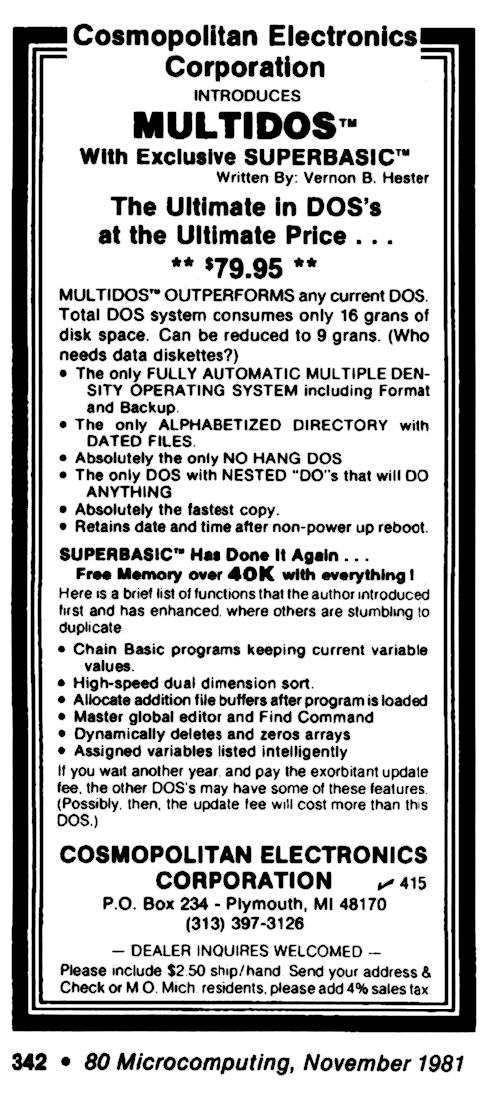
MultiDOS 1.0 Ad
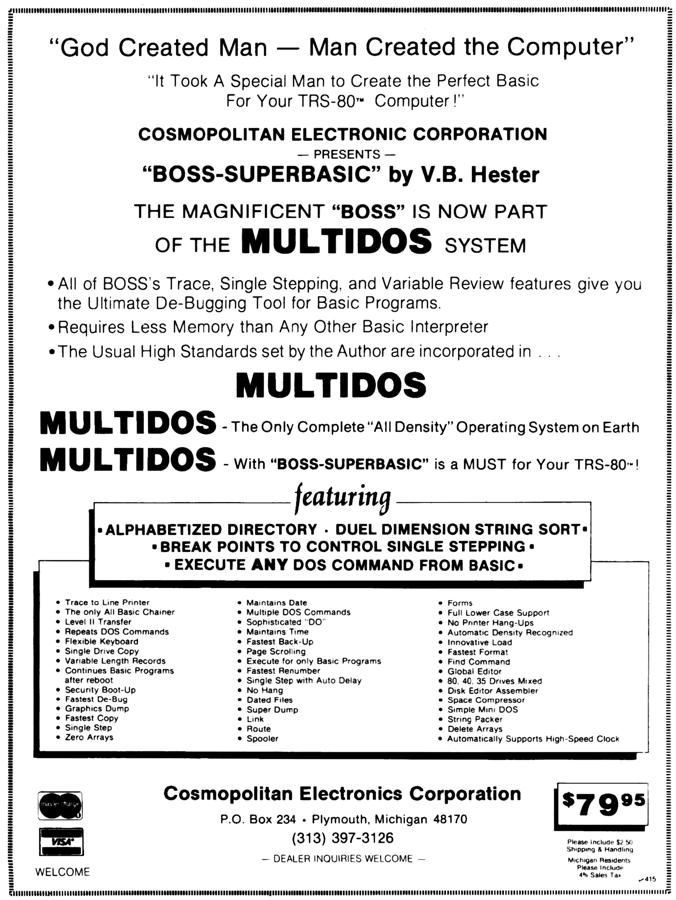
MultiDOS 1.0 Ad
MultiDOS v1.1
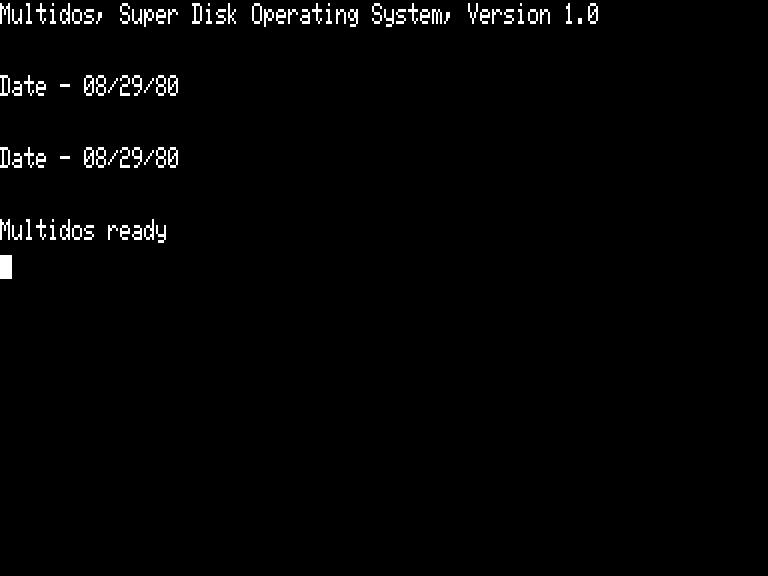
MultiDOS v1.1
Released:
Versions:
Files:
- 26 files, 12 of which still bear the v1.0 file date of September 1, 1981
Main Changes from v1.0:
- Fixed DOS0/SYS
- Added HELP/CMD
- Added SKIP/CMD
Beta Testers:
- Initial enhancements incorporated from feedback provided by: Johnn Audritsh, Charlie Butler, Mike Friedman, Andy Gariepy, Gordon Monnier, Kim Watt, and Paul Weiner.
Download Links:
Background:
Kim Watt discovered a “fatal bug” in DOS0/SYS, and since MULTIDOS v1.0 did not have a ZAP utility, Vernon had to send all his customers (about 10 at the time) a new diskette. Vernon did not advance the version number (so it still reads v1.0).
What was the bug? Well, there are five ways to interface to a dual-sided disk drive: [1] treat it as a two drives, [2] treat it as an 80 track drive. i.e., if the cylinder is above 39, subtract 40 and select side 1 (this is the way MAXIDOS interfaced with dual-sided drives), [3] treat it as a two-volume diskette (original way DOSPLUS interfaced to dual-sided drives). MULTIDOS/ESOTERIC still supports this scheme, [4] treat it as a one-volume diskette (original way LDOS interfaced to dual-sided drives). MULTIDOS/ESOTERIC supports this scheme, and [5] treat it as a one-volume with overflow.
The intent was to initially write to side zero and use side one only if side zero is full. This is the way DOS0/SYS was designed (incomplete at the time Vernon had to ship product). Vernon thought he had sufficiently ‘JRed’ around the ‘overflow code’ before Vernon shipped any – but he didn’t. Subsequently, Vernon abandoned the ‘overflow’ concept.
Contained the following files:
BACKUP/CMD
Duplicate diskette. Includes format
BASIC/CMD
High level interpreter
BBASIC/CMD
High level interpreter with BOSS
COPY/CMD
Duplicate a single file
CREF/SYS
Cross reference for BASIC including reserved words
DIR/SYS
Contains pertinent information
about the files on the disk
DOS4/SYS
Error library for DOS
EA/CMD
Editor Assembler (Enhancements only)
EDIT/SYS
Global editor for BASIC
ERROR/SYS
Error library for BASIC
FORMAT/CMD
Format [blank] diskette
GR/CMD
Enables graphic characters in BASIC
HELP/CMD
Help for Library commands + others
RENUM/SYS
Renumber for BASIC programs
SKIP/CMD
Enable reading a 40 track diskette (48 tpi) in 80 track drive (96 tpi)
VFU/CMD
Versatile File Utility
Contained the following library commands:
APPEND
ATTRIB
AUTO
BOOT
BREAK
BUILD
CLEAR
CLOCK
CONFIG
DATE
DEAD
DEBUG
DEVICE
DIR
DO
DUMP
FORMS
FREE
HASH
KEYBRD
KILL
LIB
LINK
LIST
LOAD
PRINT
PROT
RENAME
ROUTE
TIME
TOPMEM
VERIFY
Advertisements:
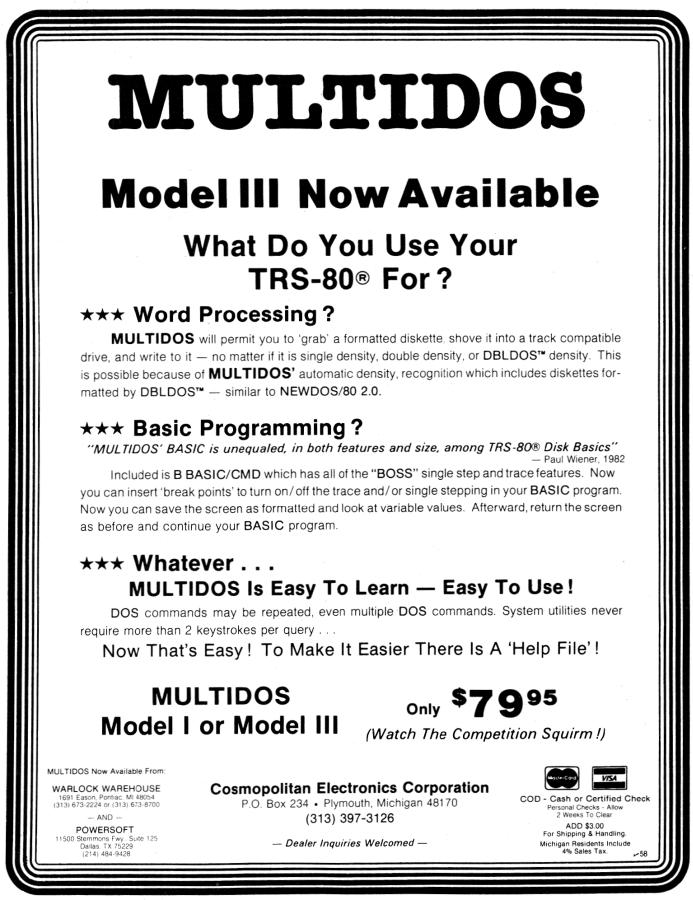
MultiDOS 1.1 Ad
MultiDOS v1.2
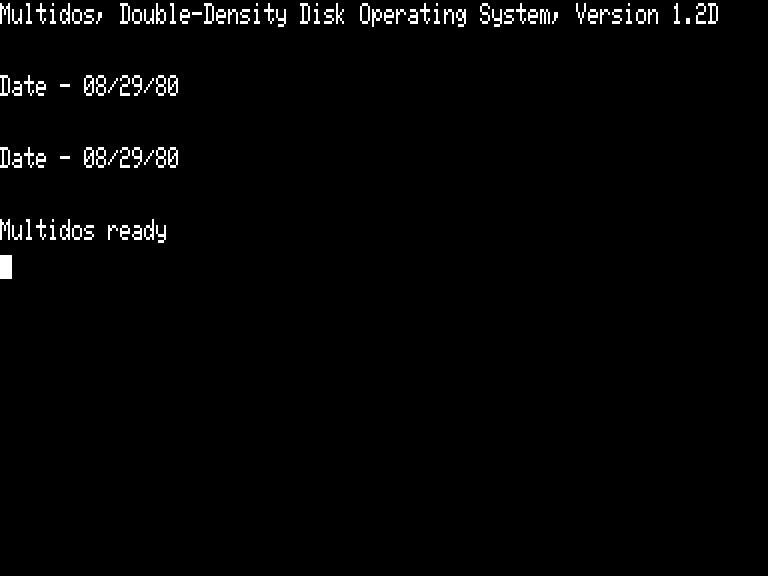
MultiDOS 1.2
Released:
Versions:
- Model I (Single, Double, and Pseudo)
- Model III
Download Links:
Contained the following files:
BACKUP/CMD
Duplicate diskette. Includes format
BASIC/CMD
High level interpreter
BBASIC/CMD
High level interpreter with BOSS
COPY/CMD
Duplicate a single file
CREF/SYS
Cross reference for BASIC including reserved words
DIR/SYS
Contains pertinent information
about the files on the disk
DOS4/SYS
Error library for DOS
EA/CMD
Editor Assembler (Enhancements only)
EDIT/SYS
Global editor for BASIC
ERROR/SYS
Error library for BASIC
FORMAT/CMD
Format [blank] diskette
GR/CMD
Enables graphic characters in BASIC
HELP/CMD
Help for Library commands + others
RENUM/SYS
Renumber for BASIC programs
SKIP/CMD
Enable reading a 40 track diskette (48 tpi) in 80 track drive (96 tpi)
VFU/CMD
Versatile File Utility
Contained the following library commands:
APPEND
ATTRIB
AUTO
BOOT
BREAK
BUILD
CLEAR
CLOCK
CONFIG
DATE
DEAD
DEBUG
DEVICE
DIR
DO
DUMP
FORMS
FREE
HASH
KEYBRD
KILL
LIB
LINK
LIST
LOAD
PRINT
PROT
RENAME
ROUTE
TIME
TOPMEM
VERIFY
MultiDOS v1.3
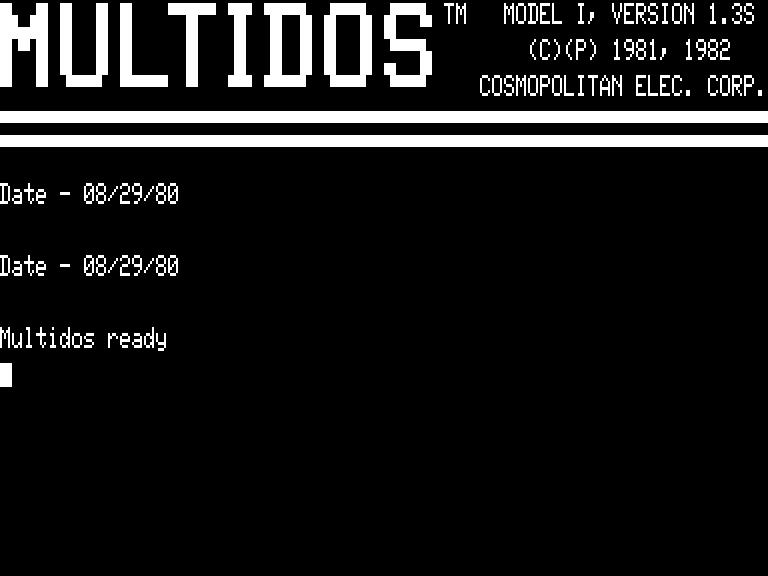
MultiDOS 1.3
Released:
- April 23, 1982 (Model I)
- April 29, 1982 (Model III)
Versions:
- Model I (Single, Double, and Pseudo)
- Model III
Main Changes from v1.2:
- Added CONVERT/CMD
- Added PATCH/CMD
Banner:
- Model I on Track 0, Sector 1
- Model III on Track 0, Sector 4
Download Links:
Contained the following files:
BACKUP/CMD
Duplicate diskette. Includes format
BASIC/CMD
High level interpreter
BBASIC/CMD
High level interpreter w/BOSS
CAT/CMD
Directory of any TRS-80 normal diskette (M3 Only)
CONVERT/CMD
Modify DIR/SYS data address marks (DAMs)
COPY/CMD
Duplicate a single file
CREF/SYS
Cross reference for BASIC including reserved words
DIR/SYS
Contains pertinent information about the files on the disk
DOS4/SYS
Error library for DOS
DOS8/SYS
Library 2 (M3 Only)
DOS9/SYS
Help for Library commands + (M3 Only)
EA/DOC
Mini “READ ME” file about EA/CMD (M3 Only)
EDIT/SYS
Global editor for BASIC
ERROR/SYS
Error library for BASIC
FORMAT/CMD
Format [blank] diskette
GR/CMD
Enables graphic characters in BASIC (Model I Only)
HELP/CMD
Help for Library commands + others (Model I Only)
PATCH/CMD
Patch a program/file (Model I Only)
RENUM/SYS
Renumber for BASIC programs
SKIP/CMD
Enable reading a 40 track diskette (48 tpi) in 80 track drive (96 tpi) (Model I Only)
TU/CMD
Modified VFU to copy files
FROM a MODEL III TRSDOS 1.3
diskette (M3 Only)
VFU/CMD
Versatile File Utility
Contained the following library commands: [Red = Model III Only]
APPEND
ATTRIB
AUTO
BLINK
BOOT
BREAK
BUILD
CLEAR
CLOCK
CLRDSK
CLS
CONFIG
DATE
DEAD
DEBUG
DEVICE
DIR
DO
DUMP
FORMS
FREE
HASH
HELP
KEYBRD
KILL
LIB
LINK
LIST
LOAD
PATCH
PRINT
PROT
RENAME
RESTORE
ROUTE
SETCOM
SKIP
TIME
TOPMEM
VERIFY
MultiDOS v1.4
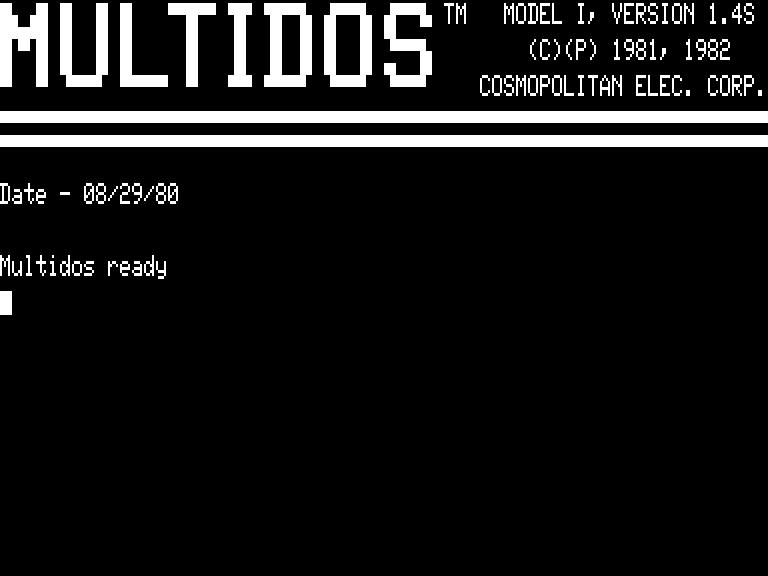
MultiDOS 1.4S
Released:
Versions:
- Model I (Single, Double, and Pseudo)
(There was no Model III version)
Main Changes from v1.3:
- HELP/CMD became DOS9/SYS
- DOS6/SYS split into DOS6/SYS and DOS8/SYS
- Added EA/DOC
- Added CAT/CMD
DOS Banner Location:
- Single-density banner on track 16, sector 9
- Double-density banner on track 1, sector 1
Download Links:
Background:
Released to allow the Model I version 1.4 to catch up with the Model III version 1.3 in having 40 Library commands.
Contained the following files:
BACKUP/CMD
Duplicate diskette. Includes format
BASIC/CMD
High level interpreter
BBASIC/CMD
High level interpreter w/BOSS
CAT/CMD
Directory of any TRS-80 normal diskette
COPY/CMD
Duplicate a single file
CREF/SYS
Cross reference for BASIC including reserved words
DIR/SYS
Contains pertinent information about the files on the disk
DOS4/SYS
Error library for DOS
DOS9/SYS
Help for Library commands +
EA/DOC
Mini “READ ME” file about EA/CMD
EDIT/SYS
Global editor for BASIC
ERROR/SYS
Error library for BASIC
FORMAT/CMD
Format [blank] diskette
GR/CMD
Enables graphic characters in BASIC
RENUM/SYS
Renumber for BASIC programs
TU/CMD
Modified VFU to copy files FROM a MODEL III TRSDOS 1.3 diskette
VFU/CMD
Versatile File Utility
Contained the following library commands:
APPEND
ATTRIB
AUTO
BLINK
BOOT
BREAK
BUILD
CLEAR
CLOCK
CLRDSK
CLS
CONFIG
DATE
DDAM
DEAD
DEBUG
DEVICE
DIR
DO
DUMP
FORMS
FREE
HASH
HELP
KEYBRD
KILL
LIB
LINK
LIST
LOAD
PATCH
PRINT
PROT
RENAME
RESTORE
ROUTE
SKIP
TIME
TOPMEM
VERIFY
MultiDOS v1.5
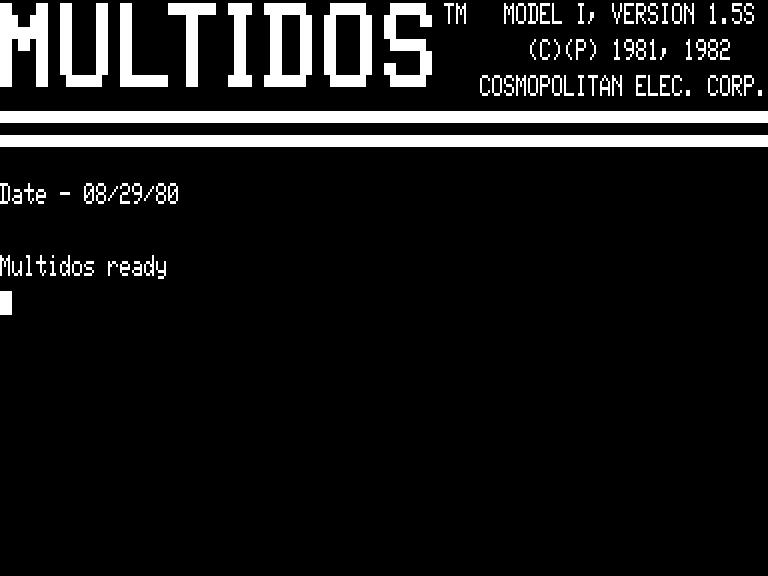
MultiDOS 1.5
Released:
Versions:
- Model I (Single, Double, Pseudo, and Kernel)
Main Changes from v1.4:
- Added DBLFIX/CMD
- Added ZAP/CMD
- Automatic recognition of Doublers
DOS Banner Location:
- Single-density banner on track 16, sector 9
- Double-density banner on track 0, sector 2
Download Links:
Contained the following files:
BACKUP/CMD
Duplicate diskette. Includes format
BASIC/CMD
High level interpreter
BBASIC/CMD
High level interpreter w/BOSS
CAT/CMD
Directory of any TRS-80 normal diskette
COPY/CMD
Duplicate a single file
CREF/SYS
Cross reference for BASIC including reserved words
DBLFIX/CMD
Easier read/writes to DBLDOS system and data diskettes
DIR/SYS
Contains pertinent information about the files on the disk
DOS4/SYS
Error library for DOS
DOS9/SYS
Help for Library commands +
EA/DOC
Mini “READ ME” file about EA/CMD
EDIT/SYS
Global editor for BASIC
ERROR/SYS
Error library for BASIC
FORMAT/CMD
Format [blank] diskette
GR/CMD
Enables graphic characters in BASIC
RENUM/SYS
Renumber for BASIC programs
TU/CMD
Modified VFU to copy files FROM a MODEL III TRSDOS 1.3 diskette
VFU/CMD
Versatile File Utility
ZAP/CMD
Disk/RAM inspect/modify utility (05/22/82)
Contained the following library commands:
APPEND
ATTRIB
AUTO
BLINK
BOOT
BREAK
BUILD
CLEAR
CLOCK
CLRDSK
CLS
CONFIG
DATE
DDAM
DEAD
DEBUG
DEVICE
DIR
DO
DUMP
FORMS
FREE
HASH
HELP
KEYBRD
KILL
LIB
LINK
LIST
LOAD
PATCH
PRINT
PROT
RENAME
RESTORE
ROUTE
SKIP
TIME
TOPMEM
VERIFY
Advertisements:
MultiDOS v1.6
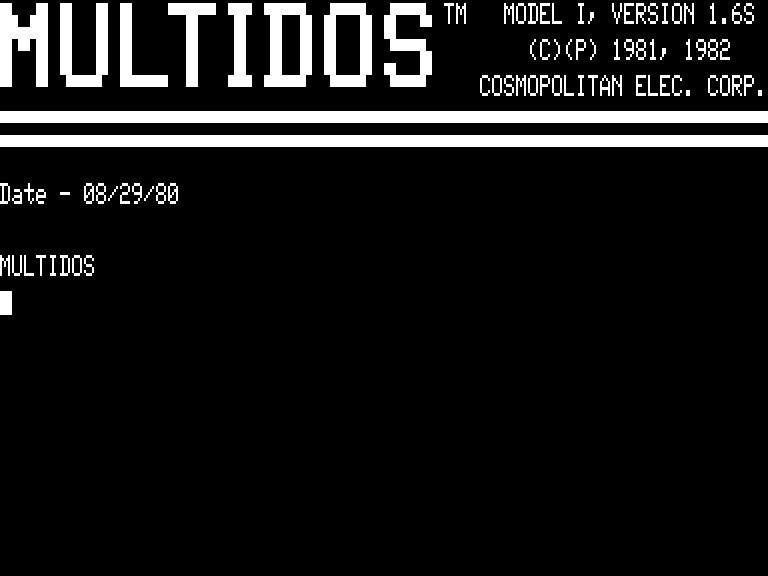
MultiDOS 1.6S
Released:
- September 25, 1982 (Model I)
- November 8, 1982 (Model III)
Versions:
- Model I (Single, Double, and Pseudo)
- Model III
Main Changes from v1.5:
- Format pattern selectable
- Added DDT/CMD
- Added TAPE/CMD
- Added automatic configuration for any doubler installed
- Merged TU/CMD into VFU/CMD
- v1.6b contained a minor change to BASIC/CMD
- v1.6.? updated CAT/CMD
- v1.6.? updated BASIC/CMD
DOS Banner Location:
- Model I banner track 0, sector 6
- Model III banner track 0, sector 4
Download Links:
Contained the following files:
BACKUP/CMD
Duplicate diskette. Includes format
BASIC/CMD
High level interpreter
BBASIC/CMD
High level interpreter w/BOSS
CAT/CMD
Directory of any TRS-80 normal diskette
CONVERT/CMD
Modify DIR/SYS data address marks (DAMs) (M3 Only)
COPY/CMD
Duplicate a single file
CREF/SYS
Cross reference for BASIC including reserved words
DBLFIX/CMD
Easier read/writes to DBLDOS system and data diskettes (Model I Only)
DDT/CMD
Diskette drive rotation speed display (11/07/82)
DIR/SYS
Contains pertinent information about the files on the disk
DOS4/SYS
Error library for DOS
DOS9/SYS
Help for Library commands +
EDIT/SYS
Global editor for BASIC
ERROR/SYS
Error library for BASIC
FORMAT/CMD
Format [blank] diskette
GR/CMD
Enables graphic characters in BASIC (Model I Only)
MEM/CMD
RAM memory test (01/28/83)
PACK/SYS
BASIC program packer (M3 Only)
RENUM/SYS
Renumber for BASIC programs
TAPE/CMD
Faster Cassette Utility
VFU/CMD
Versatile File Utility
ZAP/CMD
Disk/RAM inspect/modify utility
Contained the following library commands: [Red = Model III Only]
APPEND
ATTRIB
AUTO
BLINK
BOOT
BREAK
BUILD
CLEAR
CLOCK
CLRDSK
CLS
CONFIG
DATE
DDAM
DEAD
DEBUG
DEVICE
DIR
DO
DUMP
FORMS
FREE
HASH
HELP
KEYBRD
KILL
LIB
LINK
LIST
LOAD
PATCH
PRINT
PROT
RENAME
RESTORE
ROUTE
SETCOM
SKIP
TIME
TOPMEM
VERIFY
Advertisements:
MultiDOS v1.7
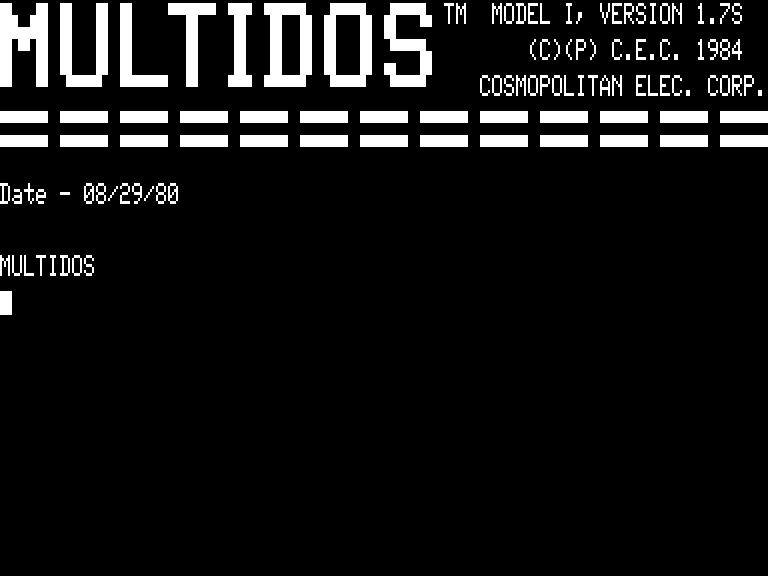
MultiDOS 1.7S
Released:
- December 6, 1983 (v1.7 for MAX-80)
- January 25, 1984 (v1.7b for MAX-80)
- May 1, 1984 (v1.7c for MAX-80)
- September 10, 1984 (v1.7d for MAX-80)
- September 15, 1984 (v1.7 for Model I)
- January 9, 1985 (Model 4)
- January 15, 1985 (v1.7a for Model 4)
- January 18, 1985 (v1.7e for MAX-80)
- September 15, 1984 (v1.7 for Model III)
Versions:
- Model I (Single, Double, and Pseudo)
Single-Density was a 2-Disk Set - Model III
- Model 4
- MAX-80
Main Changes from v1.6:
- Mainly merged DIR/SYS and DOS/SYS from v1.6 into INDEX
- Added drive control table for Model I and Model III.
- Removed FORMS code from resident DOS disappointing many customers.
- First version for the Model 4
- Model 4 v1.7a added PRT/CMD and SETCOM/CMD
- First version for the MAX-80
- MAX-80 version was rushed to ship, so 7 programs were not converted. MAX-80 v1.7b added CAT/CMD, DBLFIX/CMD, DDT/CMD, MEM/CMD, RS/CMD, VFU/CMD, and ZAP/CMD
- MAX-80 v1.7c split ‘Index’ into RESIDENT/SYS and DIR/SYS
- MAX-80 v1.7d added TA/CMD
- MAX-80 v1.7e added CDIR/CMD, FMAP/CMD, LO/CMD, MEMDISK/CMD, PRT/CMD, and SETCOM/CMD. Renamed RESIDENT/SYS to SYSRES/SYS and built in type-ahead
DOS Banner Location:
- v1.7D and v1.7 banner appeared on track 0, sector 2
- Model 4 banner appeared on track 0, sector 2
- MAX-80 v1.7 and v1.7b banners appear on track 0, sector 13
- MAX-80 v1.7c and v1.7d banners appear on track 0, sector 12
- MAX-80 v1.7e banner appears on track 0, sector 2
Download Links:
v1.7 for Model I Contained the following files:
BACKUP/CMD
Duplicate diskette. Includes format
BASIC/CMD
High level interpreter
BBASIC/CMD
High level interpreter with BOSS
CAT/CMD
Directory of any TRS-80 normal diskette
COPY/CMD
Duplicate a single file
CREF/BOL
Cross reference for BASIC including reserved words
DBLFIX/CMD
Easier read/writes to DBLDOS system and data diskettes
DDT/CMD
Diskette drive rotation speed display
DIR/SYS
Contains pertinent information about the files on the disk
EDIT/BOL
Global editor for BASIC
ERROR/BOL
Error library for BASIC
Error/DOL
Error library for DOS
FORMAT/CMD
Format [blank] diskette
GR/CMD
Enables graphic characters in BASIC
HELP/CMD
Help for Library commands +
PACK/BOL
BASIC program packer
PRT/CMD
FORMS and print filter
RENUM/BOL
Renumber for BASIC programs
TAPE/CMD
Faster Cassette Utility
UNPACK/BOL
Unpacker for BASIC programs
UTIL/BOL
BASIC overlay for F, M, N, CMD”C”, CMD”V”, CMD”X”
VFU/CMD
Versatile File Utility
ZAP/CMD
Disk/RAM inspect/modify utility
v1.7 for Model III/4 Contained the following files:
BACKUP/CMD
Duplicate diskette. Includes format
BASIC/CMD
High level interpreter
BASIC/SEG
SWAP area replacement overlay (Model 4 Only)
BBASIC/CMD
High level interpreter with BOSS (M3 Only)
CAT/CMD
Directory of any TRS-80 normal diskette
CDIR/CMD
Clear removed file’s directory entry
CONVERT/CMD
Modify DIR/SYS data address marks (DAMs)
COPY/CMD
Duplicate a single file
CREF/BOL
Cross reference for BASIC including reserved words
DBLFIX/CMD
Easier read/writes to DBLDOS system and data diskettes
DDT/CMD
Diskette drive rotation speed display
DIR/SYS
Contains pertinent information about the files on the disk
EDIT/BOL
Global editor for BASIC
ERROR/BOL
Error library for BASIC
Error/DOL
Error library for DOS
FMAP/CMD
Free map of disk usage
FORMAT/CMD
Format [blank] diskette
GR/CMD
Enables graphic characters in BASIC (Model I Only)
HELP/CMD
Help for Library commands + (M3 Only)
Help/EXT
Help for Library commands + (Model 4 Only)
MEMDISK/CMD
Memory disk (Model 4 Only)
PACK/BOL
BASIC program packer
PRT/CMD
FORMS and print filter (M3 Only)
RENUM/BOL
Renumber for BASIC programs
RESIDENT/SYS
Resident (M3 Only)
RESOLVE/BOL
Label resolver (i.e., convert to appropriate line numbers) (Model MAX-80 and Model 4 Only)
SORT/BOL
CMD”Q” overlay (MAX-80 and Model 4 Only)
SPOOL/CMD
RAM SPOOLer (M3 Only)
SYSRES/SYS
Resident (Model 4 Only)
TA/CMD
Type-Ahead (M3 Only)
TAPE/CMD
Faster Cassette Utility (M3 Only)
UNPACK/BOL
Unpacker for BASIC programs
UTIL/BOL
BASIC overlay for F, M, N, CMD”C”, CMD”V”, CMD”X”
VFU/CMD
Versatile File Utility
ZAP/CMD
Disk/RAM inspect/modify utility
v1.7a for the Model 4 contained the following ADDITIONAL files:
SETCOM/CMD
RS-232-C configuration
v1.7 for the MAX-80 contained the following files:
BACKUP/CMD
Duplicate diskette. Includes format
BAS1/SEG
SWAP area replacement overlay
BAS2/SEG
SWAP area replacement overlay
BASIC/CMD
High level interpreter
CONVERT/CMD
Modify DIR/SYS data address marks (DAMs)
COPY/CMD
Duplicate a single file
CREF/BOL
Cross reference for BASIC including reserved words
EDIT/BOL
Global editor for BASIC
ERROR/BOL
Error library for BASIC
ERROR/DOL
Error library for DOS
FORMAT/CMD
Format [blank] diskette
HELP/EXT
Help for Library commands +
INDEX/
Combined DOS/SYS and DIR/SYS
PACK/BOL
BASIC program packer
RENUM/BOL
Renumber for BASIC programs
RESOLVE/BOL
Label resolver (i.e., convert to appropriate line numbers)
UNPACK/BOL
Unpacker for BASIC programs (sorely needed after executing PACK)
UTIL/BOL
new BASIC overlay for F, M, N, CMD”C”, CMD”V”, CMD”X”
v1.7b for the MAX-80 contained the following ADDITIONAL files:
CAT/CMD
Directory of any TRS-80 normal diskette
DBLFIX/CMD
Easier read/writes to DBLDOS system and data diskettes
DDT/CMD
Diskette drive rotation speed display
VFU/CMD
Versatile File Utility
ZAP/CMD
Disk/RAM inspect/modify utility
v1.7c for the MAX-80 contained the following ADDITIONAL files from 1.7b:
New Files:
DIR/SYS
Contains pertinent information about the files on the disk
Removed Files:
Index
Combined DOS/SYS and DIR/SYS
v1.7d for the MAX-80 contained the following ADDITIONAL files from 1.7c:
v1.7e for the MAX-80 contained the following ADDITIONAL files from 1.7d:
New Files:
CDIR/CMD
Clear removed file’s directory entry
FMAP/CMD
Free map of disk usage
RESOLVE/BOL
Label resolver (i.e., convert to appropriate line numbers)
SETCOM/CMD
RS-232-C configuration
Removed Files:
RESIDENT/SYS
was replaced by SYSRES/SYS (New file)
Contained the following library commands:
Model I Contained the following library commands:
APPEND
ATTRIB
AUTO
BLINK
BOOT
BUILD
CLEAR
CLOCK
CLRDSK
CLS
CONFIG
DATE
DDAM
DEAD
DEBUG
DEVICE
DIR
DO
DUMP
FORMS
FREE
KEYBRD
KILL
LIB
LINK
LIST
LOAD
PATCH
PRINT
PROT
RENAME
RESET
RESTORE
ROUTE
SCREEN
SKIP
TIME
TOPMEM
VERIFY
Model III Contained the following library commands:
APPEND
ATTRIB
AUTO
BLINK
BOOT
BUILD
CLEAR
CLOCK
CLRDSK
CLS
CONFIG
DATE
DEAD
DEBUG
DEVICE
DIR
DO
DUMP
FORMS
FREE
KEYBRD
KILL
LIB
LINK
LIST
LOAD
PATCH
PRINT
PROT
RENAME
RESET
RESTORE
ROUTE
SCREEN
SETCOM
SKIP
TIME
TOPMEM
VERIFY
Model 4 and MAX-80 Contained the following library commands:
APPEND
ATTRIB
AUTO
BLINK
BOOT
BUILD
CLEAR
CLOCK
CLRDSK
CLS
CONFIG
DATE
DEBUG
DEVICE
DIR
DO
DUMP
FORMS
FREE
HELP
KEYBRD
KILL
LIB
LINK
LIST
LOAD
PATCH
PRINT
PROT
RENAME
RESET
RESTORE
ROUTE
SCREEN
SKIP
TIME
TOPMEM
VERIFY
V64
V80
MultiDOS v1.71
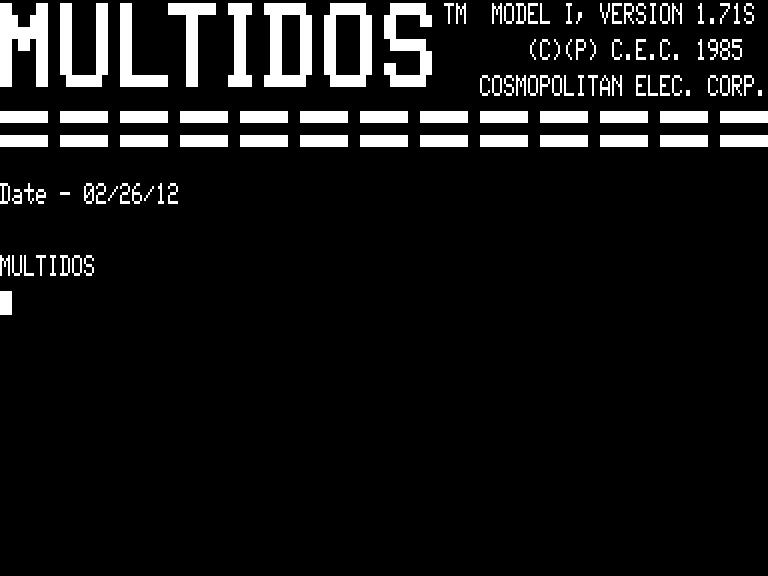
MultiDOS 1.71S
Released:
- February 11, 1985
March 4, 1985 (Model 4)
Versions:
- Model I (Single, Double, and Pseudo)
[Single-Density was a 2-Disk Set] - Model III
- Model 4
- MAX-80
Main Changes:
- Access NEWDOS/80 diskettes with GPL > 2
- Added CDIR/CMD
- Added FMAP/CMD
- Added LO/CMD
- Added MEMDISK/CMD
- Added PRT/CMD
- Added SETCOM/CMD
Download Links:
Model III Contained the following files:
BACKUP/CMD
Duplicate diskette. Includes format
BASIC/CMD
High level interpreter
BBASIC/CMD
High level interpreter with BOSS
CAT/CMD
Directory of any TRS-80 normal diskette
CDIR/CMD
Clear removed file’s directory entry
CONVERT/CMD
Modify DIR/SYS data address marks (DAMs) (Model III, MAX-80, and Model 4)
COPY/CMD
Duplicate a single file
CREF/BOL
Cross reference for BASIC including reserved words
DBLFIX/CMD
Easier read/writes to DBLDOS system and data diskettes
DDT/CMD
Diskette drive rotation speed display
DIR/SYS
Contains pertinent information about the files on the disk
EDIT/BOL
Global editor for BASIC
ERROR/BOL
Error library for BASIC
Error/DOL
Error library for DOS
FMAP/CMD
Free map of disk usage
FORMAT/CMD
Format [blank] diskette
GR/CMD
Enables graphic characters in BASIC
HELP/CMD
Help for Library commands +
PACK/BOL
BASIC program packer
PRT/CMD
FORMS and print filter
RENUM/BOL
Renumber for BASIC programs
TAPE/CMD
Faster Cassette Utility
UNPACK/BOL
Unpacker for BASIC programs
UTIL/BOL
BASIC overlay for F, M, N, CMD”C”, CMD”V”, CMD”X”
VFU/CMD
Versatile File Utility
ZAP/CMD
Disk/RAM inspect/modify utility
Model III version contained the following library commands:
APPEND
ATTRIB
AUTO
BLINK
BOOT
BUILD
CLEAR
CLOCK
CLRDSK
CLS
CONFIG
DATE
DEAD
DEBUG
DEVICE
DIR
DO
DUMP
FORMS
FREE
KEYBRD
KILL
LIB
LINK
LIST
LOAD
PATCH
PRINT
PROT
RENAME
RESET
RESTORE
ROUTE
SCREEN
SETCOM
SKIP
TIME
TOPMEM
VERIFY
MultiDOS v2.0
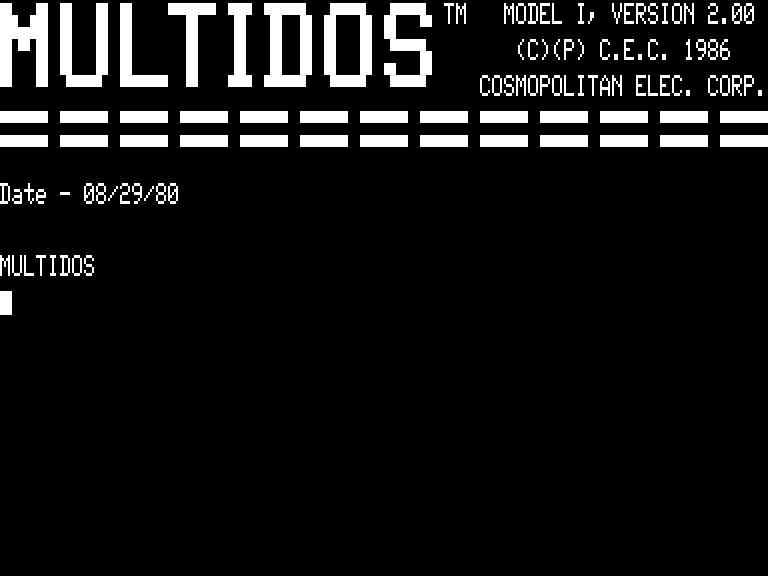
MultiDOS v2.0
Released:
- October 1, 1985
- January 1, 1986 (Model 4)
Versions:
- Model I (Single, Double, and Pseudo)
- Model III
- Model 4
- MAX-80
Main Changes:
- Included SKIP as a CONFIG parameter
- Ensure that GAT bytes CCH and CDH were per TRSDOS 6 documentation (not what TRSDOS 6 does)
- Added T4/CMD
- Added TWO/IDO
- Added SPOOL/CMD that can use expanded memory
- Added and SYSGEN/CMD
- Implemented side compare implemented
- Enhanced CMD”V” to display array values
- Enhanced SORT/BOL (MAX-80 & Model 4) to do multi-key/indirect sort
- Model 4 version allowed for hard drive support
Download Links:
Model I, III and 4 versions contained the following files (Red is for ONLY the models listed):
BACKUP/CMD
Duplicate diskette. Includes format
BASIC/CMD
High level interpreter
BASIC/SEG (4)
SWAP area replacement overlay
BBASIC/CMD (I/III)
High level interpreter with BOSS
CAT/CMD
Directory of any TRS-80 normal diskette
CDIR/CMD
Clear removed file’s directory entry
CONVERT/CMD (4)
Modify DIR/SYS data address marks (DAMs)
COPY/CMD
Duplicate a single file
CREF/BOL
Cross reference for BASIC including reserved words
DBLFIX/CMD
Make easier read/writes to DBLDOS system and data diskettes
DDT/CMD
Diskette drive rotation speed display
DIR/SYS
Contains pertinent information about the files on the disk
EDIT/BOL
Global editor for BASIC
ERROR/BOL
Error library for BASIC
Error/DOL
Error library for DOS
FMAP/CMD
Free map of disk usage
FORMAT/CMD
Format [blank] diskette
GR/CMD (I/III)
Enables graphic characters in BASIC
HELP/CMD (I/III)
Help for Library commands +
Help/EXT (4)
Help for Library commands +
PACK/BOL
BASIC program packer
PRT/CMD
FORMS and print filter
RENUM/BOL
Renumber for BASIC programs
RESOLVE/BOL (4)
Label resolver (i.e., convert to appropriate line numbers)
SETCOM/CMD (4)
RS-232-C configuration
SORT/BOL (4)
CMD”Q” overlay
SYSGEN/CMD (4)
SYSRES/SYS and DIR/SYS creator
T4/CMD (4)
Double-Sided Shell
TAPE/CMD (I/III)
Faster Cassette Utility
TWO/IDO (4)
DO file for making double-sided system diskettes
UNPACK/BOL
Unpacker for BASIC programs
UTIL/BOL
BASIC overlay for F, M, N, CMD”C”, CMD”V”, CMD”X”
VFU/CMD
Versatile File Utility
ZAP/CMD
Disk/RAM inspect/modify utility
Max-80 version contained the following files:
BACKUP/CMD
Duplicate diskette. Includes format
BAS1/SEG
SWAP area replacement overlay
BAS2/SEG
SWAP area replacement overlay
BASIC/CMD
High level interpreter
CAT/CMD
Directory of any TRS-80 normal diskette
CDIR/CMD
Clear removed file’s directory entry
CONVERT/CMD
Modify DIR/SYS data address marks (DAMs)
COPY/CMD
Duplicate a single file
CREF/BOL
Cross reference for BASIC including reserved words
DBLFIX/CMD
Make easier read/writes to DBLDOS system and data diskettes
DDT/CMD
Diskette drive rotation speed display
DIR/SYS
Contains pertinent information about the files on the disk
EDIT/BOL
Global editor for BASIC
ERROR/BOL
Error library for BASIC
Error/DOL
Error library for DOS
FMAP/CMD
Free map of disk usage
FORMAT/CMD
Format [blank] diskette
Help/EXT
Help for Library commands +
PACK/BOL
BASIC program packer
RENUM/BOL
Renumber for BASIC programs
RESOLVE/BOL
Label resolver (i.e., convert to appropriate line numbers)
SETCOM/CMD
RS-232-C configuration
SPOOL/CMD
RAM/expanded RAM SPOOLer
UNPACK/BOL
Unpacker for BASIC programs (sorely needed after executing PACK)
UTIL/BOL
BASIC overlay for F, M, N, CMD”C”, CMD”V”, CMD”X”
VFU/CMD
Versatile File Utility
ZAP/CMD
Disk/RAM inspect/modify utility
v2.0 contained the following library commands:
APPEND
ATTRIB
AUTO
BLINK
BOOT
BUILD
CLEAR
CLOCK
CLRDSK
CLS
CONFIG
DATE
DDAM (I/III)
DEAD (I/III)
DEBUG
DEVICE
DIR
DO
DUMP
FORMS
FREE
HELP (4/MAX)
KEYBRD
KILL
LIB
LINK
LIST
LOAD
PATCH
PRINT
PROT
RENAME
RESET
RESTORE
ROUTE
SCREEN
TIME
TOPMEM
TYPE (4/MAX)
V64 (4/MAX)
V80 (4/MAX)
VERIFY
MultiDOS v2.1
Released:
- October 1, 1987
- August 1, 1987 (Model 4)
Versions:
- Model I (Single, Double, and Pseudo)
- Model III
- Model 4
- MAX-80
Main Changes:
- Included a new date format to include time and extend maximum date to 12/31/2011
- GAT byte CBH now available for cylinder 203
- Added FIXDATE/CMD to change a disk’s date format
- Added SYSGEN/CMD to create various SYSRES/SYS configurations
Download Links:
FIXDATE/CMD:
FIXDATE [:]d [(param[,ABS][,CHECK][,G])]<ENTER>
FIXDATE (H)<ENTER>
d = drive number — the drive number is mandatory.
param = 1) ZT converts 1.0 through 2.0 to 3.xx format (default parameter if none specified).
param = 2) TZ converts 3.xx to 1.0 through 2.0 format.
param = 3) OZ converts 2.1x to 1.0 through 2.0 format.
param = 4) ZO converts 1.0 through 2.0 to 2.1x format.
param = 5) OT converts 2.1x to 3.xx format.
param = 6) TO converts 3.xx to 2.1x format.
ABS or A = Specifies update files that are probably in the previous format to the new format.
CHECK or C=Display the files to be changed without changing them.
GAT or G = Update GAT bytes CCH and CDH to represent the number of physical cylinders less 35 in CCH, and the diskette’s configuration in CDH (see the discussion of these two bytes in the DIRECTORY STRUCTURE section).
H = Help.
FIXDATE/CMD changes the date format among the three formats used by MULTIDOS. It is recommended that you convert your disks once. It is relatively easy to convert your disks from 2.0 to the format used by 3.xx; however, the conversion from 2.1x to 3.xx or 3.xx to 2.1x may require the ABS parameter. The ABS parameter is used to convert files that their date format cannot be interpreted properly. Normally, during initial conversions, you would not use this parameter. However, it may be required if you are going to convert back to the 2.0 format with the TZ and/or REV parameter. Version 2.1x uses the bytes previously assigned to the access password to store the hour, minute, and year. The previous bytes for the date remained. Version 3.xx uses the bytes previously assigned to the update and access passwords to store the year, month, day, hour, minute, and seconds divided by two. The previous bytes used for the date are now used for the access password. ESOTERIC only uses the 3.xx format.
Although FIXDATE/CMD automatically updates the bytes on the GAT table at locations CCH and CDH (for use with Open/DOL on Version 2.11 or later) whenever any file’s date is converted, you may specify the G parameter to force this action if none of the dates are converted. Open/DOL, for versions 2.11 or later, has been changed to only access a diskette if the drive’s configuration agrees with the diskette’s configuration. i.e., if you put a single sided diskette in a drive that is configured double sided, Open/DOL does not open the file and returns “Drive Configuration Error.” (DOS error 40/28H). However, [V]FU/CMD has built in error messages and returns “Unknown error.”
FIXDATE/CMD will not change the dates on a floppy diskette in logical drive zero, and so the parameter :d was mandatory.
Contained the following files:
BACKUP/CMD
Duplicate diskette. Includes format
BAS1/SEG
SWAP area replacement overlay (MAX-80 Only)
BAS2/SEG
SWAP area replacement overlay (MAX-80 Only)
BASIC/CMD
High level interpreter
BASIC/SEG
SWAP area replacement overlay (Model 4)
BBASIC/CMD
High level interpreter with BOSS (Model I and iI Only)
CAT/CMD
Directory of any TRS-80 normal diskette
CDIR/CMD
Clear removed file’s directory entry
CONVERT/CMD
Modify DIR/SYS data address marks (DAMs) (Model iI, 4, and MAX-80)
COPY/CMD
Duplicate a single file
CREF/BOL
Cross reference for BASIC including reserved words
DBLFIX/CMD
Make easier read/writes to DBLDOS system and data diskettes
DDT/CMD
Diskette drive rotation speed display
DIR/SYS
Contains pertinent information about the files on the disk
EDIT/BOL
Global editor for BASIC
ERROR/BOL
Error library for BASIC
Error/DOL
Error library for DOS
FIXDATE/CMD
Date format changer
FMAP/CMD
Free map of disk usage
FORMAT/CMD
Format [blank] diskette
GR/CMD
Enables graphic characters in BASIC (Model I and iI)
HELP/CMD
Help for Library commands + (Model I and iI)
Help/EXT
Help for Library commands + (Model 4 and MAX-80)
INSTALL/CMD
Hard Disk update utility (Model iI and 4)
PACK/BOL
BASIC program packer
PRT/CMD
FORMS and print filter
RENUM/BOL
Renumber for BASIC programs
RESOLVE/BOL
Label resolver (i.e., convert to appropriate line numbers) (Model iI and 4)
SETCOM/CMD
RS-232-C configuration (Model iI and 4)
SORT/BOL
CMD”Q” overlay (Model iI and 4)
SYSGEN/CMD
SYSRES/SYS and DIR/SYS creator
T3/CMD
Double-Sided Shell (Model iI)
T4/CMD
Double-Sided Shell (Model 4)
TAPE/CMD
Faster Cassette Utility (Model I and Model iI)
TWO/IDO
DO file for making double-sided system diskettes (M3 and M4)
UNPACK/BOL
Unpacker for BASIC programs (sorely needed after executing PACK)
UTIL/BOL
BASIC overlay for F, M, N, CMD”C”, CMD”V”, CMD”X”
VFU/CMD
Versatile File Utility
ZAP/CMD
Disk/RAM inspect/modify utility
Contained the following library commands:
Append
Attrib
Auto
Blink
Boot
Build
Clear
Clock
Clrdsk
Cls
Config
Date
Ddam (M1)
Dead (M1/M3)
Debug
Device
Dir
Do
Dump
Forms
Free
Help (M4/MAX)
Keybrd
Kill
Lib
Link
List
Load
Patch
Print
Prot
Rename
Reset
Restore
Route
Screen
Setcom (M3)
Time
Topmem
Type (M3/M4/MAX)
V64 (M4/MAX)
V80 (M4/MAX)
Verify
MultiDOS v2.11
Released:
Versions:
Main Changes:
- Compensate for the ‘brain dead’ HD64180 microprocessor supplied with the XLR8er that alleged 8MHz processing for the TRS-80
- Added CP/CMD
- Added XCOPY/CMD
- Initial release of PCOPY (called XCOPY in 1990). Pcopy was written for a customer of Vernon’s who had a very large mailing list on his hard disk and wanted a backup in case his hard disk failed or he upgraded to another hard disk. Anyway, he pointed Vernon toward an application that DOSPLUS had, and Vernon created PCOPY. If you don’t have a hard drive, PCOPY is not much use. Let us say you want to backup a 300K file, and all you have handy is seven floppies with about 50K free on each. You can use PCOPY to backup your 300K file onto these seven floppies. And, you can restore any backup set. One must keep track on what set of floppies are in a given set because PCOPY will not let on mix floppies from different sets.
Contained the following files:
BACKUP/CMD
Duplicate diskette. Includes format
BASIC/CMD
High level interpreter
BASIC/SEG
SWAP area replacement overlay
CAT/CMD
Directory of any TRS-80 normal diskette
CDIR/CMD
Clear removed file’s directory entry
CONVERT/CMD
Modify DIR/SYS data address marks (DAMs)
COPY/CMD
Duplicate a single file
CP/CMD
Utility to compare two files
CREF/BOL
Cross reference for BASIC including reserved words
DBLFIX/CMD
Make easier read/writes to DBLDOS system and data diskettes
DDT/CMD
Diskette drive rotation speed display
DIR/SYS
Contains pertinent information about the files on the disk
EDIT/BOL
Global editor for BASIC
ERROR/BOL
Error library for BASIC
Error/DOL
Error library for DOS
FIXDATE/CMD
Date format changer
FMAP/CMD
Free map of disk usage
FORMAT/CMD
Format [blank] diskette
Help/EXT
Help for Library commands +
INSTALL/CMD
Hard Disk update utility
PACK/BOL
BASIC program packer
RENUM/BOL
Renumber for BASIC programs
RESOLVE/BOL
Label resolver (i.e., convert to appropriate line numbers)
SETCOM/CMD
RS-232-C configuration
SPOOL/CMD
RAM/expanded RAM SPOOLer
SYSGEN/CMD
SYSRES/SYS and DIR/SYS creator
TWO/IDO
DO file for making double-sided system diskettes
UNPACK/BOL
Unpacker for BASIC programs (sorely needed after executing PACK)
UTIL/BOL
BASIC overlay for F, M, N, CMD”C”, CMD”V”, CMD”X”
VFU/CMD
Versatile File Utility
XCOPY/CMD
Utility to copy large files onto multiple diskettes
ZAP/CMD
Disk/RAM inspect/modify utility
Contained the following library commands:
APPEND
ATTRIB
AUTO
BLINK
BOOT
BUILD
CLEAR
CLOCK
CLRDSK
CLS
CONFIG
DATE
DEBUG
DEVICE
DIR
DO
DUMP
FORMS
FREE
HELP
KEYBRD
KILL
LIB
LINK
LIST
LOAD
PATCH
PRINT
PROT
RENAME
RESET
RESTORE
ROUTE
SCREEN
TIME
TOPMEM
TYPE
VERIFY
V64
V80
MultiDOS v3.00-v3.11
Released:
- April 1, 1987 (v3.00)
- December 1, 1996 (v3.01)
- March 1, 1997 (v3.10)
- March 1, 1998 (v3.11)
Note:
- Sold through Computer News 80 and contained special Computer News 80 utilities on the DOS disk.
MultiDOS v4.00
Official Build:
Versions:
Notes:
MultiDOS v4.01
Released:
Versions:
- Model I (Single, Double, and Pseudo)
- Model III
Download Links:
MultiDOS v5.00
Official Build:
Versions:
Main Changes:
- Implement major changes in the video routine.
Notes:
MultiDOS v5.1
Official Build:
Versions:
Notes:
MultiDOS v5.11
Official Build:
- December 22, 2004 (and dated January 1, 2005)
Versions:
Contained the following files:
BACKUP/CMD
Duplicate diskette. Includes format
BASIC/CMD
High level interpreter
BASIC/SEG
SWAP area replacement overlay
CONVERT/CMD
Modify DIR/SYS data address marks (DAMs)
COPY/CMD
Duplicate a single file
CREF/BOL
Cross reference for BASIC including reserved words
CUSTOM/CMD
Customizing Utility
DBLFIX/CMD
Make easier read/writes to DBLDOS system and data diskettes
DDT/CMD
Diskette drive rotation speed display
DIR/SYS
Contains pertinent information about the files on the disk
EDIT/BOL
Global editor for BASIC
ERROR/BOL
Error library for BASIC
Error/DOL
Error library for DOS
FIXDATE/CMD
Date format changer
FORMAT/CMD
Format [blank] diskette
GRAF/BOL
BASIC overlay that contains the characters set for printing text, block graphics, and special characters on the high-resolution screen.
INSTALL/CMD
Hard Drive Installation Utility
MODULE/CMD
High memory management utility (please see page 64 in the MULTIDOS documentation).
MONITOR/CMD
High-memory real time debugger that supersedes DEBUG/DOL (please see page 65 in the MULTIDOS documentation)
MRHARD/CMD
Matthew Reed Hard Drive Format Support
PACK/BOL
BASIC program packer
PCOPY/CMD
Backup/Restore Large Files onto Multiple Floppies
PRT/CMD
FORMS and print filter
RENUM/BOL
Renumber for BASIC programs
RESOLVE/BOL
Label resolver (i.e., convert to appropriate line numbers)
SETCOM/CMD
RS-232-C configuration
SHOW/CMD
Continuously Display Bytes at Specified Mem Location
SYSGEN/CMD
SYSRES/SYS and DIR/SYS creator
TWO/IDO
DO file for making double-sided system diskettes
UNPACK/BOL
Unpacker for BASIC programs
UTIL/BOL
BASIC overlay for F, M, N, CMD”C”, CMD”V”, CMD”X”
UTIL2/BOL
BASIC overlay that contains the code for the CMD”Y” suite of BASIC commands (please see page 123 in the MULTIDOS documentation)
VFU/CMD
Versatile File Utility
ZAP/CMD
Disk/RAM inspect/modify utility
Contained the following library commands:
Append
Attrib
Auto
Blink
Build
Cat
Cdir
Clear
Clock
Clrdsk
Cls
Config
Date
Debug
Device
Dir
Do
Dump
Fmap
Forms
Free
Lib
Link
List
Load
Patch
Prot
Remove
Rename
Reset
Restor
Route
Screen
Spool
Time
Topmem
Type
V64
V80
Verify
MultiDOS v5.00
(Vernon-B-Hester).gif)
MultiDOS v5.00
Click to Enlarge
Official Build: February 24, 2021
Versions: Model I and III
Main Changes: BASIC/CMD, BBASIC/CMD, RA/CMD, OPT/BOL, and UTIL/BOL were updated. CAT/CMD and Open/DOL were zapped.
Download Links:
MultiDOS v5.10
(Vernon-B-Hester).gif)
MultiDOS v5.10
Official Build: October 12, 2023
Versions: Model I and III
Download Links:
Main Changes:
File name
Rev. Date
Change Description
Allocate/DOL
01/30/22
Valuing of C too late. Moved LD C,(IX+6) from UGDEN to VERN (MULTIDOS/ESOTERIC system advanced release).
BASIC/CMD
05/20/23
Honed 18Jun22 code: If BASICH nests BASIC and back to BASICH, Hi-RES is blanked after review.
BASIC/CMD (I/III)
03/31/21
Updated to enable usage with TRS80gp emulator’s ability to write enable ROM and incorporate ROM fixes.
BCPATCH/CMD
07/14/23
STDIC/ASM modified for changes in SYSRES/SYS and ESORES/SYS perpetual clock.
CLJVPAT/CMD
07/14/23
STDIC/ASM modified for changes in SYSRES/SYS and ESORES/SYS perpetual clock.
CLMRPAT/CMD
07/14/23
STDIC/ASM modified for changes in SYSRES/SYS and ESORES/SYS perpetual clock.
ESORES/SYS
03/03/23
Perpetual clock efficiency [release 3.2]. Date is from KIPVESO/ASM
HELP/CMD (I/III/C)
10/08/23
Updated help text for CONFIG – added missing ‘N’ parameter.
INSTALL/CMD
08/26/23
Added Model I. Requires d* to do Open/Close and overwrite instead of update to latest version.
Library1/EXT
03/25/23
SPOOL modified to use ERADW for expanded memory status instead of checking for expanded memory. MAX-80: DATE modified to update day of week in ERADW and clock chip. HELP modified to enable MAX-80 and MOD 4 to display all in 64×16 video mode.
Library2/EXT
09/30/23
CONFIG reduced ‘normal’ floppy data from two screen lines to one screen line. HELP added ‘N’ parameter.
Library3/EXT
03/25/23
HELP modified to enable MAX-80 and MOD 4 to display all in 64×16 video mode.
SYSRES/SYS (4)
03/03/23
Perpetual clock efficiency [release 6.2]. Date is from KIPMOD4/ASM
SYSRES/SYS (M)
03/16/23
Major overhaul to catch up with 25+ years of changes to Model 4/ESOTERIC and added day of week storage.
TCPATCH/CMD
07/04/23
STDIC/ASM modified for changes in SYSRES/SYS and ESORES/SYS perpetual clock.
ZAP/CMD
04/29/21
Updated methodology to handle shuffling virtual hard disks because of capabilities with emulators.
MultiDOS v6.00
(Vernon-B-Hester).gif)
MultiDOS v6.00
Official Build: February 24, 2021
Version: Model 4
Main Changes: BASIC/CMD, Library3/EXT, MEMDISK/CMD, MODULE/CMD, MONITOR/CMD, RA/CMD, SORT/BOL, UTIL/BOL were all changed.
Download Links:
MultiDOS v6.20
(Vernon-B-Hester).gif)
MultiDOS v6.20
Official Build: October 14, 2023
Versions: Model 4
Download Links:
Main Changes:
File name
Rev. Date
Change Description
Allocate/DOL
01/30/22
Valuing of C too late. Moved LD C,(IX+6) from UGDEN to VERN (MULTIDOS/ESOTERIC system advanced release).
BASIC/CMD
05/20/23
Honed 18Jun22 code: If BASICH nests BASIC and back to BASICH, Hi-RES is blanked after review.
BASIC/CMD (1/3)
03/31/21
Updated to enable usage with TRS80gp emulator’s ability to write enable ROM and incorporate ROM fixes.
BCPATCH/CMD
07/14/23
STDIC/ASM modified for changes in SYSRES/SYS and ESORES/SYS perpetual clock.
CLJVPAT/CMD
07/14/23
STDIC/ASM modified for changes in SYSRES/SYS and ESORES/SYS perpetual clock.
CLMRPAT/CMD
07/14/23
STDIC/ASM modified for changes in SYSRES/SYS and ESORES/SYS perpetual clock.
ESORES/SYS
03/03/23
Perpetual clock efficiency [release 3.2]. Date is from KIPVESO/ASM
HELP/CMD (1/3/C)
10/08/23
Updated help text for CONFIG – added missing ‘N’ parameter.
INSTALL/CMD
08/26/23
Added Model I. Requires d* to do Open/Close and overwrite instead of update to latest version.
Library1/EXT
03/25/23
SPOOL modified to use ERADW for expanded memory status instead of checking for expanded memory. MAX-80: DATE modified to update day of week in ERADW and clock chip. HELP modified to enable MAX-80 and MOD 4 to display all in 64×16 video mode.
Library2/EXT
09/30/23
CONFIG reduced ‘normal’ floppy data from two screen lines to one screen line. HELP added ‘N’ parameter.
Library3/EXT
03/25/23
HELP modified to enable MAX-80 and MOD 4 to display all in 64×16 video mode.
SYSRES/SYS (4)
03/03/23
Perpetual clock efficiency [release 6.2]. Date is from KIPMOD4/ASM
SYSRES/SYS (M)
03/16/23
Major overhaul to catch up with 25+ years of changes to Model 4/ESOTERIC and added day of week storage.
TCPATCH/CMD
07/04/23
STDIC/ASM modified for changes in SYSRES/SYS and ESORES/SYS perpetual clock.
ZAP/CMD
04/29/21
Updated methodology to handle shuffling virtual hard disks because of capabilities with emulators.
Z’DOS
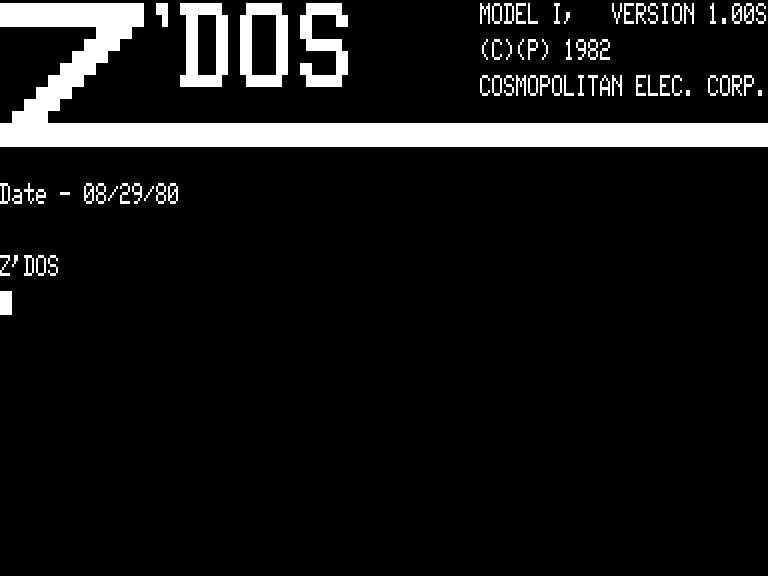
Z’DOS v1.00
Released:
- September 30, 1982 (Model I/Single Density)
- November 19, 1982 (Model I/Double Density)
- November 20, 1982 (Model III)
Versions:
- Model I (Single and Double)
- Model III
Download Links:
Background:
Vernon wrote and released Z’DOS as an attempt to get people into something other than TRSDOS at a reasonable cost. Z’DOS v1.0 was never updated.
Contained the following files:
BACKUP/CMD
Duplicate diskette. Includes format
BASIC/CMD
High level interpreter
COPY/CMD
Duplicate a single file
CREF/SYS
Cross reference for BASIC including reserved words
DIR/SYS
Contains pertinent information about the files on the disk
EDIT/SYS
Global editor for BASIC
ERROR/SYS
Error library for BASIC
FORMAT/CMD
Format [blank] diskette
RENUM/SYS
Renumber for BASIC programs
Contained the following library commands:
APPEND
ATTRIB
AUTO
BLINK
BOOT
BREAK
BUILD
CLEAR
CLOCK
CLRDSK
CLS
CONFIG
DATE
DDAM
DEAD
DEBUG
DEVICE
DIR
DO
DUMP
FORMS
FREE
HASH
HELP
KEYBRD
KILL
LIB
LINK
LIST
LOAD
PATCH
PRINT
PROT
RENAME
RESTOR
ROUTE
SKIP
TIME
TOPMEM
VERIFY
Advertisements:
Esoteric
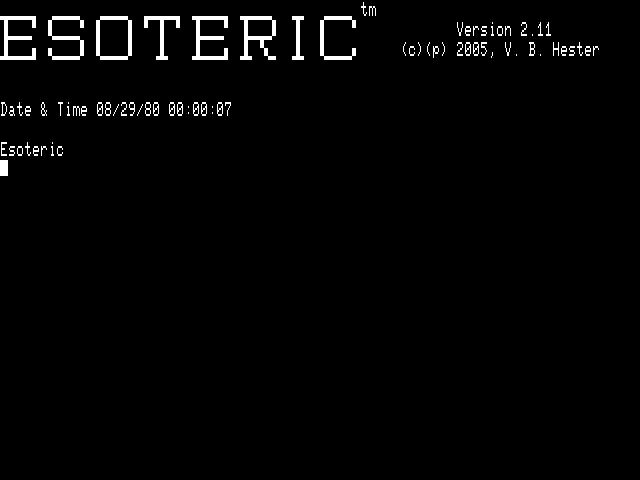
Esoteric v2.11
Released:
- July 11, 1998 (Preliminary)
- December 13, 1998 (v1.0)
- November 25, 1999 (v1.1)
- January 1, 2001 (v1.2)
- August 12, 2002 (v2.0)
- August 1, 2004 (v2.1)
- November 29, 2004 (v2.11)
Version:
Download Link:
Background:
ESOTERIC is essentially Model 4 MULTIDOS using the Model 4’s Memory Maps III and IV. MULTIDOS uses Memory Map II. The only benefit (if any) of Model 4 MULTIDOS over ESOTERIC is that Model 4 MULTIDOS can operate in both the 64×16 screen and the 80×24 screen, whereas ESOTERIC is only a 80×24 screen system.
In a March 1983 San Francisco computer show, LOBO came to Vernon’s booth and they talked about the MAX-80. In April 1983 a MAX-80 arrived in Vernon’s office and he began to convert Model I DOS to work in the MAX-80. The MAX-80 was capable of either 64×16 or 80×24 video. Vernon cobbled a version of BASIC using fragments of the Model I ROM and his Model I/III disk BASIC. The primary purpose of the dual video was to enable an easy transition of Model I/III BASIC programs to a faster machine (5.06667 MHz) without having to rewrite display code. And, the 80×24 screen could be used for new developments and/or converted 64×16 stuff. Programs such as “Android Nim” execute flawlessly in Model 4 MULTIDOS – provided, of course, that one is in the 64×16 video mode.
Vernon did not want to do a Model 4 MULTIDOS; however, many customers wanted the ‘easier’ transition to a 4MHz/80×24 capable machine. Therefore, Vernon converted his MAX-80 version of MULTIDOS to the Model 4. To be clear, first came the MAX-80 MULTIDOS, and second came the Model 4 version of MULTIDOS. ESOTERIC would have been the Model 4 version of MULTIDOS if Vernon had planned on competing with TRSDOS 6 in either late 1983 and/or early 1984. MAX-80 MULTIDOS hit the streets in September 1983, and Model 4 MULTIDOS was not released until February 1985 – customers were begging. One of the ‘easier’ transitions the Model 4 MULTIDOS provided is the exact matching of 115 of 124 keywords (the nine mismatches are minor).
Vernon created ESOTERIC in June 1998 (as he had nothing else to do with his Model 4) to gain the 2048 bytes consumed by the permanent address space used for the keyboard and video in Memory Map II. The primary difference between ESOTERIC and Model 4 MULTIDOS is the video (80×24 vs. either 80×24 or 64×16) and ESOTERIC is mapped significantly different than Model 4 MULTIDOS. The mapping of the Model 4 is very similar to the Model I, Model III, and MAX-80 version of MULTIDOS. ESOTERIC’s mapping difference was desired to keep the DOS in contiguous memory (0000H through 1AFFH). Under ESOTERIC, one can ORG applications at 1B00H.
Contained the following files on the DOS Disk:
Allocate/DOL
BACKUP/CMD
BASIC/CMD
BASIC/SEG
CONVERT/CMD
CREF/BOL
CUSTOM/CMD
Close/DOL
Command/DOL
DBLFIX/CMD
DDT/CMD
DIR/SYS
Debug/DOL
EDIT/BOL
ERROR/BOL
ESORES/SYS
Error/DOL
FIXDATE/CMD
FORMAT/CMD
FU/CMD
GRAF/BOL
INSTALL/CMD
LO/CMD
LIBRARY1/EXT
LIBRARY2/EXT
LIBRARY3/EXT
MEM/CMD
MEMDISK/CMD
MODULE/CMD
MONITOR/CMD
MRHARD/CMD
Minidos/DOL
Open/DOL
PACK/BOL
PCOPY/CMD
PRT/CMD
RA/CMD
RENUM/BOL
RESOLVE/BOL
RS/CMD
SETCOM/CMD
SHOW/CMD
SORT/BOL
SSAVER/CMD
TE/CMD
TWO/IDO
UNPACK/BOL
UTIL/BOL
UTIL2/BOL
ZAP/CMD
Contained the following files on the UTILITIES Disk:
ANNUITY/CAL
ASTROCAL/CMD
BCBIG/CMD
BCLOCK/CMD
BCPATCH/CMD
BCTEST/CMD
CAL/IDO
CALENDAR/BAS
CARDL/BAS
CLJVPAT/CMD
CLJVTEST/CMD
CLMRPAT/CMD
CLMRTEST/CMD
CUBESOL/BAS
DECTOHEX/CAL
ERR/BAS
FRAC/BAS
MEGADISK/CMD
OTHELLO/BAS
SORTVIS4/BAS
SQRSUM/BAS
STRCOLL/BAS
TCBIG/CMD
TCPATCH/CMD
TCTEST/CMD
TEST/CAL
XMEMDISK/CMD
XMONITOR/CMD
Z80Z/ASM
ZEUS/CMD
Contained the following library commands:
APPEND
ATTRIB
AUTO
BLINK
BUILD
CAT
CDIR
CLEAR
CLOCK
CLRDSK
CLS
COMP
CONFIG
COPY
DATE
DEBUG
DEVICE
DIR
DO
DUMP
FMAP
FORMS
FREE
LIB
LINK
LIST
LOAD
PATCH
PROT
REMOVE
RENAME
RESET
RESTOR
ROUTE
SCREEN
SPOOL
TIME
TOPMEM
TYPE
VERIFY
Esoteric v2.12
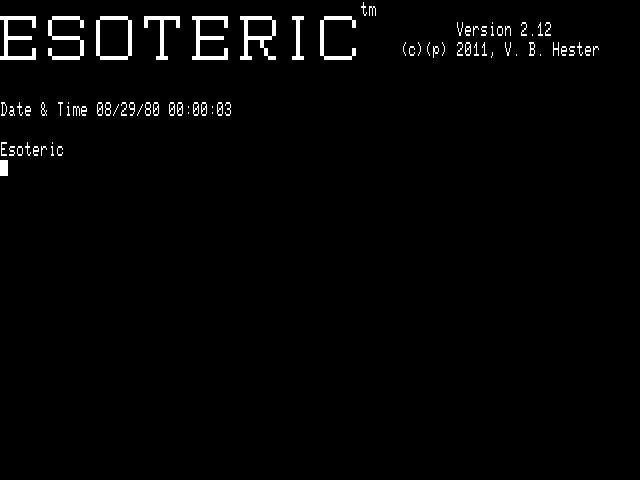
Esoteric v2.12
Released:
Version:
Download Links:
Contained the following files on the DOS disk:
Allocate/DOL
BACKUP/CMD
BASIC/CMD
BASIC/SEG
Close/DOL
Command/DOL
CONVERT/CMD
CREF/BOL
CUSTOM/CMD
DBLFIX/CMD
DDT/CMD
Debug/DOL
DIR/SYS
EDIT/BOL
ERR/BAS
ERROR/BOL
Error/DOL
ESORES/SYS
FIXDATE/CMD
FORMAT/CMD
FU/CMD
GRAF/BOL
INSTALL/CMD
LIBRARY1/EXT
LIBRARY2/EXT
LIBRARY3/EXT
LO/CMD
MEM/CMD
MEMDISK/CMD
Minidos/DOL
MODULE/CMD
MONITOR/CMD
MRHARD/CMD
Open/DOL
PACK/BOL
PCOPY/CMD
PRT/CMD
RA/CMD
RENUM/BOL
RESOLVE/BOL
RS/CMD
SETCOM/CMD
SHOW/CMD
SORT/BOL
SSAVER/CMD
TE/CMD
TWO/IDO
UNPACK/BOL
UTIL/BOL
UTIL2/BOL
ZAP/CMD
Contained the following files on the UTILITIES disk:
ANNUITY/CAL
ASTROCAL/CMD
BCBIG/CMD
BCLOCK/CMD
BCPATCH/CMD
BCTEST/CMD
BOOT/SYS
CAL/IDO
CALENDAR/BAS
CARDL/BAS
CLJVPAT/CMD
CLJVTEST/CMD
CLMRPAT/CMD
CLMRTEST/CMD
CUBESOL/BAS
DECTOHEX/CAL
DIR/SYS
FRAC/BAS
MEGADISK/CMD
MEGAMAP/CMD
OTHELLO/BAS
PAGE21/CAL
PAGE27/CAL
PAGE28/CAL
PAGE32/CAL
PAGE37/CAL
PAGE62/CAL
PAGE63/CAL
PAGE78/CAL
PAGE90/CAL
PAGE92/CAL
PAGE94/CAL
PRECMATH/BAS
RCBIG/CMD
RCLOCK/CMD
ROOT/BAS
SORTVIS4/BAS
SQRSUM/BAS
STRCOLL/BAS
TCBIG/CMD
TCPATCH/CMD
TCTEST/CMD
TEST/CAL
TRUTH/BAS
XESORES/SYS
XMEMDISK/CMD
XMONITOR/CMD
Z80Z/ASM
ZEUS/CMD
Contained the following library commands:
APPEND
ATTRIB
AUTO
BLINK
BUILD
CAT
CDIR
CLEAR
CLOCK
CLRDSK
CLS
COMP
CONFIG
COPY
DATE
DEBUG
DEVICE
DIR
DO
DUMP
FMAP
FORMS
FREE
LIB
LINK
LIST
LOAD
PATCH
PROT
REMOVE
RENAME
RESET
RESTOR
ROUTE
SCREEN
SPOOL
TIME
TOPMEM
TYPE
VERIFY
Esoteric v3.00
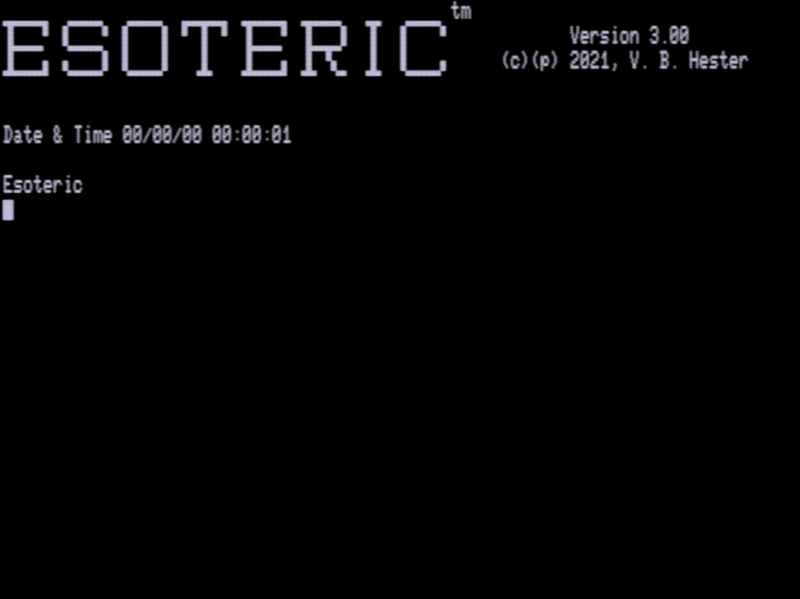
Esoteric v3.00
Released: February 23, 2021
Version: Model 4
Main Changes: Updated BASIC/CMD, Library3/EXT, MEMDISK/CMD, MODULE/CMD, MONITOR/CMD, RA/CMD, SORT/BOL and UTIL/BOL.
Download Links:
Esoteric v3.20
(Vernon-B-Hester)[M4].gif)
Esoteric v3.20
Official Build: October 14, 2023
Versions: Model 4
Download Links:
Main Changes:
File name
Rev. Date
Change Description
Allocate/DOL
01/30/22
Valuing of C too late. Moved LD C,(IX+6) from UGDEN to VERN (MULTIDOS/ESOTERIC system advanced release).
BASIC/CMD
05/20/23
Honed 18Jun22 code: If BASICH nests BASIC and back to BASICH, Hi-RES is blanked after review.
BASIC/CMD {1/3}
03/31/21
Updated to enable usage with TRS80gp emulator’s ability to write enable ROM and incorporate ROM fixes.
BCPATCH/CMD
07/14/23
STDIC/ASM modified for changes in SYSRES/SYS and ESORES/SYS perpetual clock.
CLJVPAT/CMD
07/14/23
STDIC/ASM modified for changes in SYSRES/SYS and ESORES/SYS perpetual clock.
CLMRPAT/CMD
07/14/23
STDIC/ASM modified for changes in SYSRES/SYS and ESORES/SYS perpetual clock.
ESORES/SYS
03/03/23
Perpetual clock efficiency [release 3.2]. Date is from KIPVESO/ASM
HELP/CMD {1/3/C}
10/08/23
Updated help text for CONFIG – added missing ‘N’ parameter.
INSTALL/CMD
08/26/23
Added Model I. Requires d* to do Open/Close and overwrite instead of update to latest version.
Library1/EXT
03/25/23
SPOOL modified to use ERADW for expanded memory status instead of checking for expanded memory. MAX-80: DATE modified to update day of week in ERADW and clock chip. HELP modified to enable MAX-80 and MOD 4 to display all in 64×16 video mode.
Library2/EXT
09/30/23
CONFIG reduced ‘normal’ floppy data from two screen lines to one screen line. HELP added ‘N’ parameter.
Library3/EXT
03/25/23
HELP modified to enable MAX-80 and MOD 4 to display all in 64×16 video mode.
SYSRES/SYS {4}
03/03/23
Perpetual clock efficiency [release 6.2]. Date is from KIPMOD4/ASM
SYSRES/SYS {M}
03/16/23
Major overhaul to catch up with 25+ years of changes to Model 4/ESOTERIC and added day of week storage.
TCPATCH/CMD
07/04/23
STDIC/ASM modified for changes in SYSRES/SYS and ESORES/SYS perpetual clock.
ZAP/CMD
04/29/21
Updated methodology to handle shuffling virtual hard disks because of capabilities with emulators.
Q & A With Vernon Hester
Given the evolution of the PC industry, in hindsight, what evolutionary steps could the TRS-80 (Z-80) have taken to maintained their dominance (this includes Z80 improvements, hardware, software, etc)
The 8-bit (16-bit addressing) microprocessors (8080, 6800, 6502, and Z80) can address only 64K of memory. An improvement to some of the 16-bit addressing families is a memory management unit (MMU) that enabled addressing up to 1M of memory (notably the HD64180/Z180). Although there usage could have extended the life of the TRS-80, software to effectively use this capability was non-existent. And, with the advent of microprocessors (Intel 8086) with 20-bit addressing (1M of memory) in 1978, computers with a limit of 64K were doomed; however, the Commodore 64 maintained a major market share through 1989 (Ref: Wikipedia)
The Model III, released in 1980, should have had twice the memory capacity and twice the CPU speed compared to the Model I that was released in 1978; and, the Model 4, released in 1983, should have had eight time the memory capacity and four times the CPU speed compared to the Model III. Perhaps, the Zilog development of the Z80 family hampered the TRS80 going to 14 MHz.
Here’s a simple chart of my “hindsight” on what the TRS-80 should have been:
Speed:
1.77 MHz
4.0 MHz minimum
5.1 MHz possible
8.0 MHz minimum
10.0 MHz possible
Keys:
53
59 full ASCII and CAPS plus num. pad and F1-F4
61 add ESC and CTRL plus num. pad and F1-F8
Memory:
48K
64K expandable to 128K
256K expandable to 1M
Clock:
Software
Hardware/battery backup
Hardware/battery backup
Spool:
N/A
Optional
Built in (256K min)
Hi-Res:
Optional
Optional
Built in
NOTE: Radio Shack peripherals never included a print SPOOLer. Hardware SPOOLers could have easily achieved four Megabytes by the end of 1984. I imagine a hardware SPOOLer requires a minimum of engineering; and, with no moving parts, would have an infinite life in the TRS-80 world.
The HD64180 microprocessor, released in 1985, should have been the chip used in the planned Model 5 instead of the Z800 that never came to be. By the way, the Z800 morphed into the Z280 in 1987 that bombed.
Dream System:
- The Model 5, released 1986 (based on the ‘hindsight’ evolution)
- HD64180/Z180 microprocessor with 1 megabyte of memory.
- Add six keys: Delete, Home, End, Insert, Page up, and Page down.
- New OS could extend file dating to 2107.
Radio Shack announces development of the Model 5 and urges all major software houses to start writing code for the new Z180 microprocessor. Radio Shack sells prototype machines to software developers on a first come first served basis for only the shipping and handling cost.
Summary:
- Faster microprocessors
- Full ASCII keyboard (minor – but an inconvenience)
- More Memory – at least 256K
- Give software developers a heads up on hardware modifications/upgrades
I have a perception that Radio Shack was simply arrogant when it came to the Model III and Model 4 and probably never heard of Moore’s law.
Radio Shack Model III apparent “errors”:
Model III TRSDOS developed by Radio Shack, albeit better than the initial release of the Model I DOS, was not media-storage compatible with Model I TRSDOS. All of the alternate DOSes had media-storage compatibility between the Model I and Model III. (The significant limitations and errors with Model I TRSDOS, created an opening for alternative DOSes to emerge.)
The Model III was designed to run at a microprocessor speed of ~2.03 MHz. Why only 2 MHz? The Model II released in 1979 was running at 4 MHz. Speed up kits enabled one to run the Model III at 5.07 MHz. Peter Ray (Anitek) designed a Model 4 speed up that ran the Microprocessor at (6.7/6.1/5.1) MHz and 2.03 MHz. Why couldn’t Radio Shack do ~4/2MHz. Oh, that’s the Model 4! The Model III boasted 14K ROM. For another 2K we got lowercase, faster cassette, and TIME$ – gee golly wow!
In addition, Radio Shack managed to screw up the new ROMs. Notably are the behavior in the 32 characters/line mode (0348H), the “safe” exit to basic via a JP 0072H (some people bypassed this and used 06CCH), the code to return the printer status at 05D1H, and the code at 02C3H – this was subsequently fixed because the Model III would go out to lunch if the key is pressed after keying SYSTEM. Is it because Radio Shack “explained” the behavior they did not have to fix the code?
My conclusion: The Model III should have been more than the Model 4.
Radio Shack Model 4 apparent “errors”:
The Model 4 still did not have a full ASCII keyboard. There is simply no excuse for this decision. LDOS is a decent DOS; however, many people dropped the TRS-80 line in 1983/1984 because of LDOS. Furthermore, Radio Shack and Logical Systems could not agree on a solution (cost) for the 1987 date limit in TRSDOS 6.x. Imagine if DOSPLUS, NEWDOS80, and MULTIDOS were still competing with LDOS. The date extension cost would have been zero!
My conclusion: The Model 4 is not much more than a souped-up Model I.
Overall:
With the boon years (1979-1982), Radio Shack could have created/managed a user group (ref: Heathkit) that would have provided a wealth of useful information. Of course, Radio Shack did not have to implement any of the user group’s ideas; however, Radio Shack would have had a much better idea where the industry was headed. Nevertheless, the 16-bit microprocessors trumped the 8-bit microprocessors about 1984. Zilog finally developed eZ80 in 2001. The eZ80 is an 8-bit microprocessor with 24-bit addressing: 16M linearly.
Too little too late: With VisiCalc available for the Apple II in 1979, the Apple II started outselling the TRS-80 by 1982. Radio Shack discouraged third party software developers and planned to develop all software internally or have external software developers design their software so it would only work with TRSDOS. Although VisiCalc was available for the TRS-80 in 1980 (that is too long after the Apple II), it was designed to work only with TRSDOS.
Finally, in 1985 Radio Shack sold the Model 4D with DeskMate (“D” for DeskMate). DeskMate had four useful and integrated functions – Database, word processor, spreadsheet, and a calendar. Kim Watt had that idea back in 1980!
What are some examples of your favorite Z-80 assembly “tricks” or techniques that you think fellow codes might appreciate.
Techniques
Know what and how instructions affect flags – especially the P/V flag. Flags don’t change randomly. i.e.,
- LD A,(HL)
- OR A
- JR NZ,dog
- OR A; you get here only if the zero flag is set
… is just as bad as …
Use all four flags (Sign, Zero, P/V, and Carry) – I’ve seen code where there is a tendency to use the sign flag when the carry flag will do. A possible advantage of the carry flag is a conditional branch can use a jump relative (JR) instruction instead of a jump (JP) instruction. The JR instruction is only two bytes whereas the JP requires three. And, depending on the circumstances, the JR “may” be faster.
Involve the entire instruction set. i.e., don’t hold back so that the code may be used in an 8080 environment.
Don’t write ROMable code. Whoever ROMed their code?
Where possible use the DJNZ instruction vs DEC D, DEC E, or DEC C, etc.
Use conditional calls where possible.
Use a “MONITOR” to debug and/or enhance code. The use of a monitor can possibly enable you to detect redundant code and possible “masking”. i.e.,
LD H,B
;redundant (wastes 2 bytes and 8 “t” states)
This segment is 13 bytes.
1FCD
RST 10H
;there is a branch to 1FCD
“masking” enables you to reduce by one byte. And, saves two “t” states if DE is 0.
DEFB 21H
;sequence hide the next two bytes
1FCD
RST 10H
;there is a branch to 1FCD
The “masking” values HL with some arbitrary value. This is not a problem because the HL register pair is valued with the contents of LION with the next instruction.
What are your thoughts on the evolution of microprocessors and how current OS’s take advantage of their capabilities?
This is a question I am not qualified to answer. However, I do have an opinion. Microprocessor development in the 1980’s evolved to the point where they can completely replace code to perform algebraic addition, multiplication, division, trigonometric functions, square roots, logarithmic, and exponentiation in both single-precision and double-precision. Now they can perform string compare. This has enabled OS’s and applications to develop only the high-level algorithms and not bother with the primitive functions. Resulting in faster development of new applications.
Would you ever release your source code to the public domain so that others could learn from your code?
Yes.







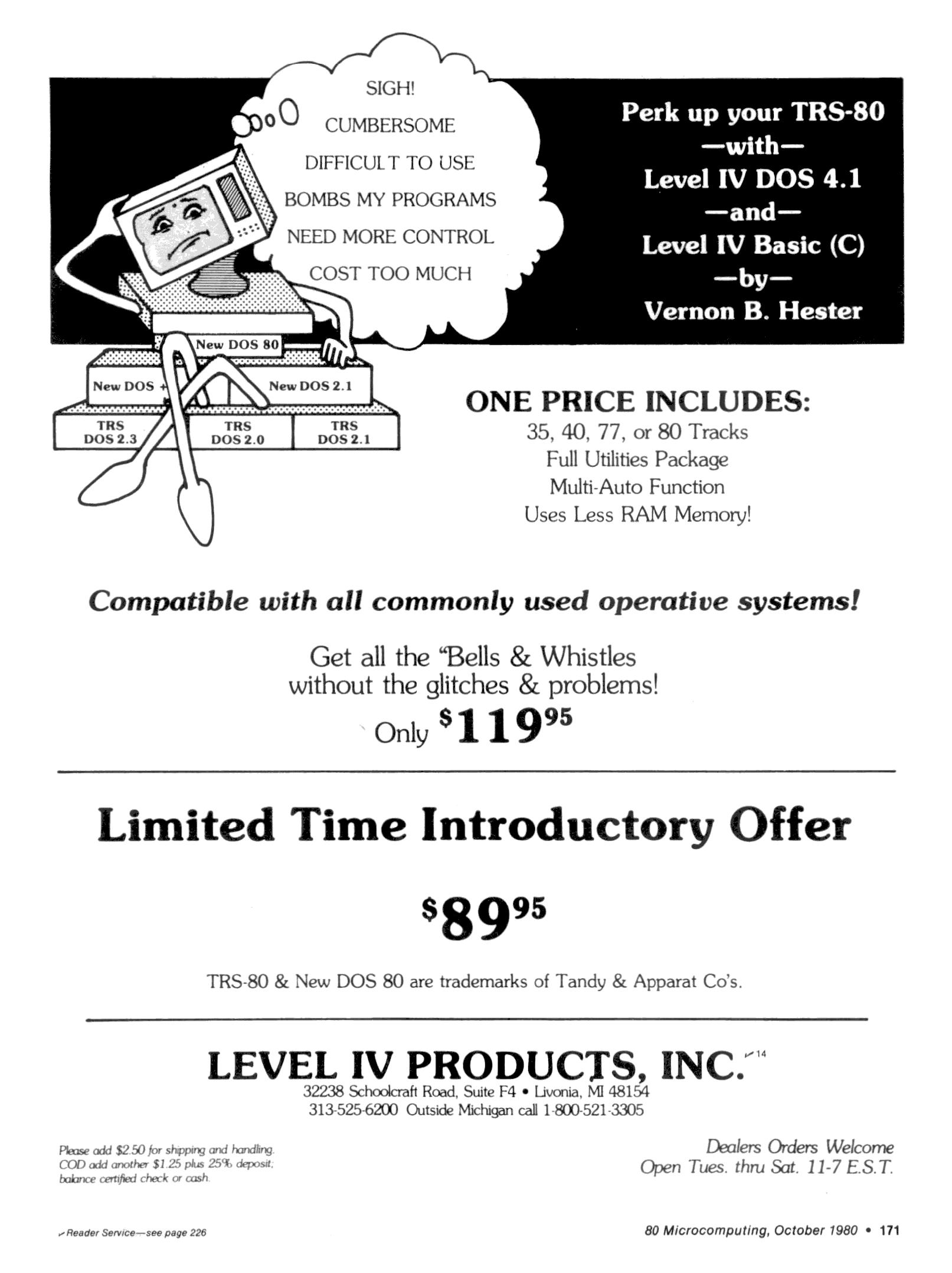
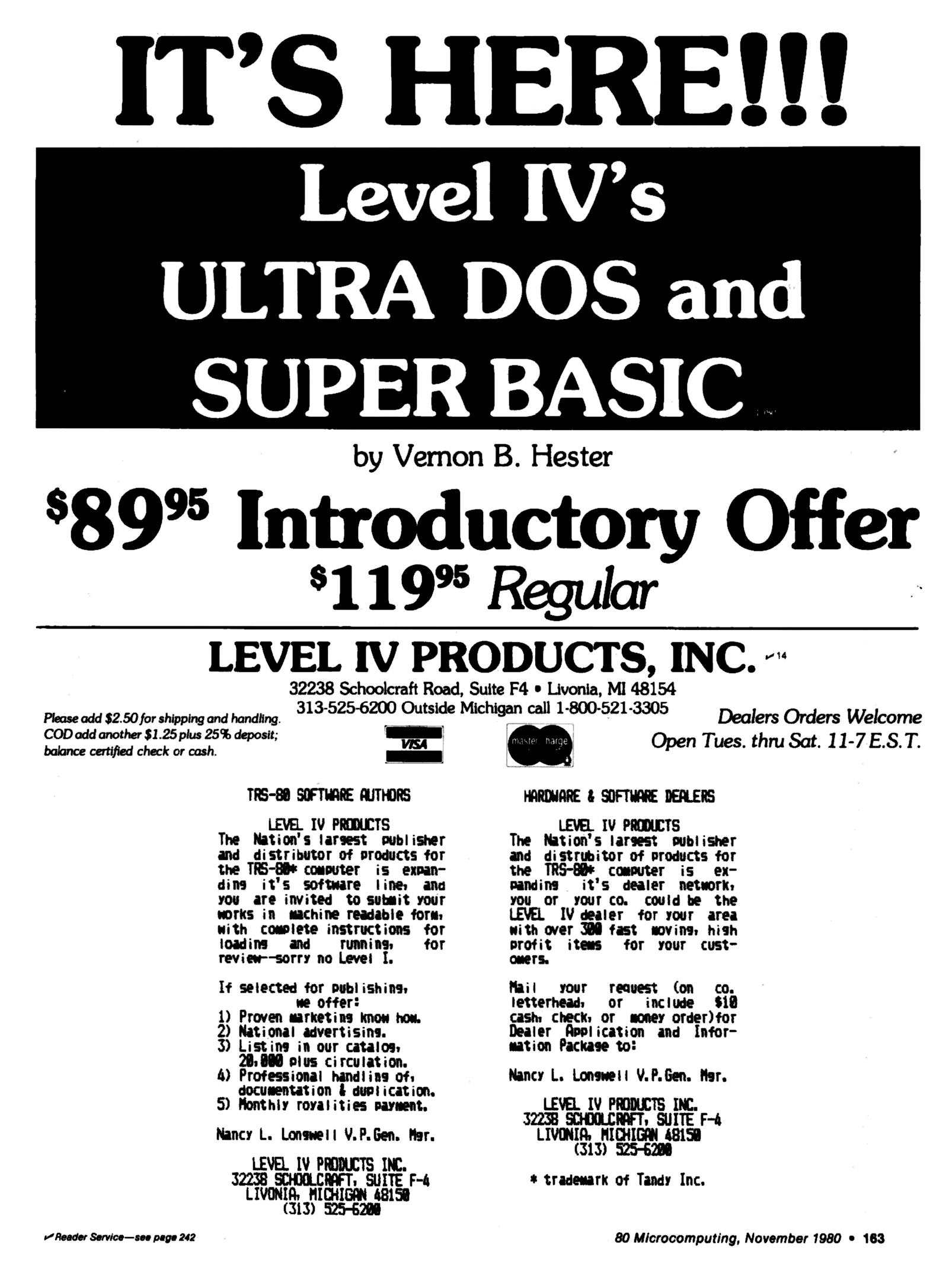
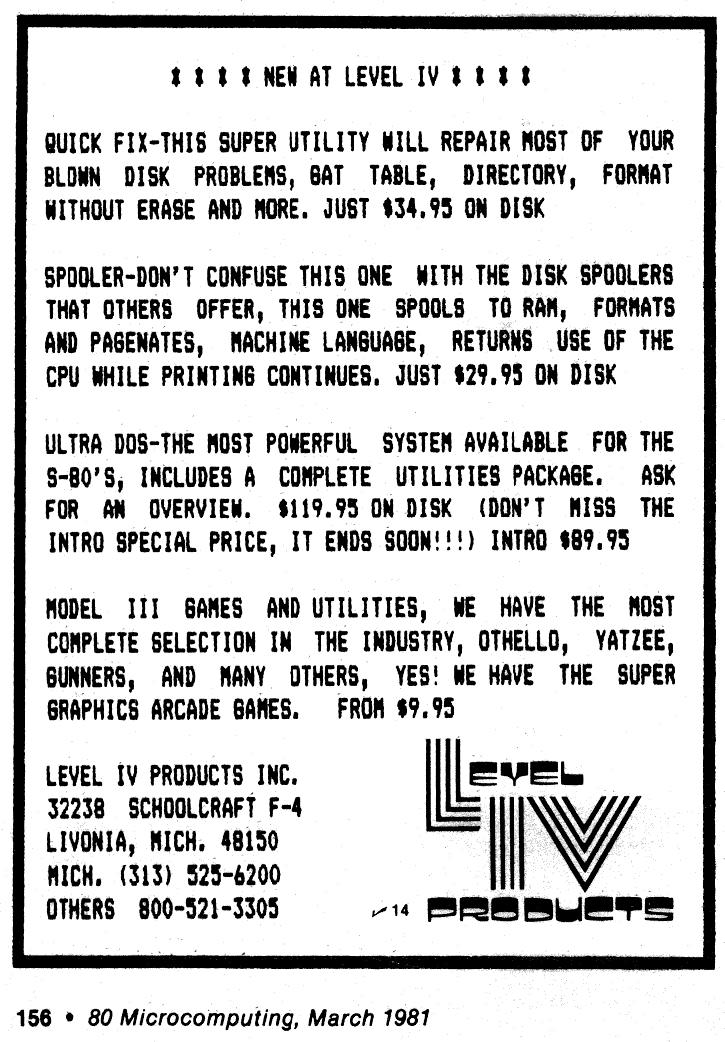
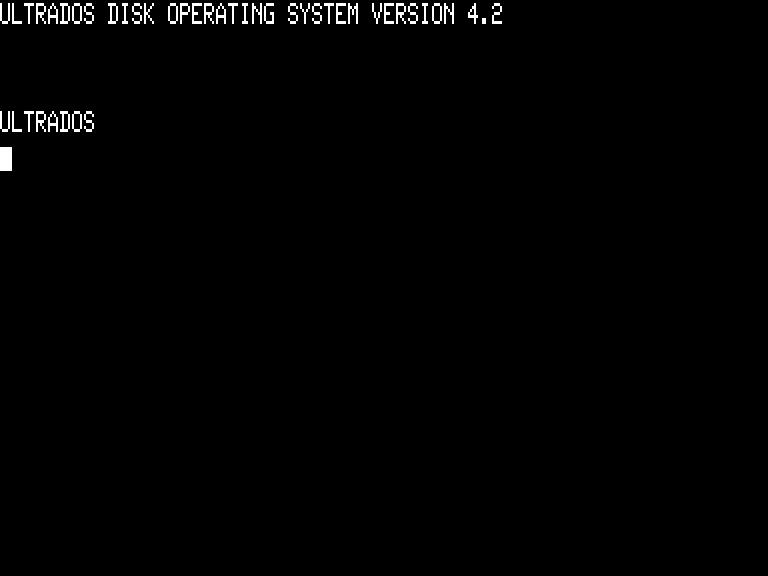
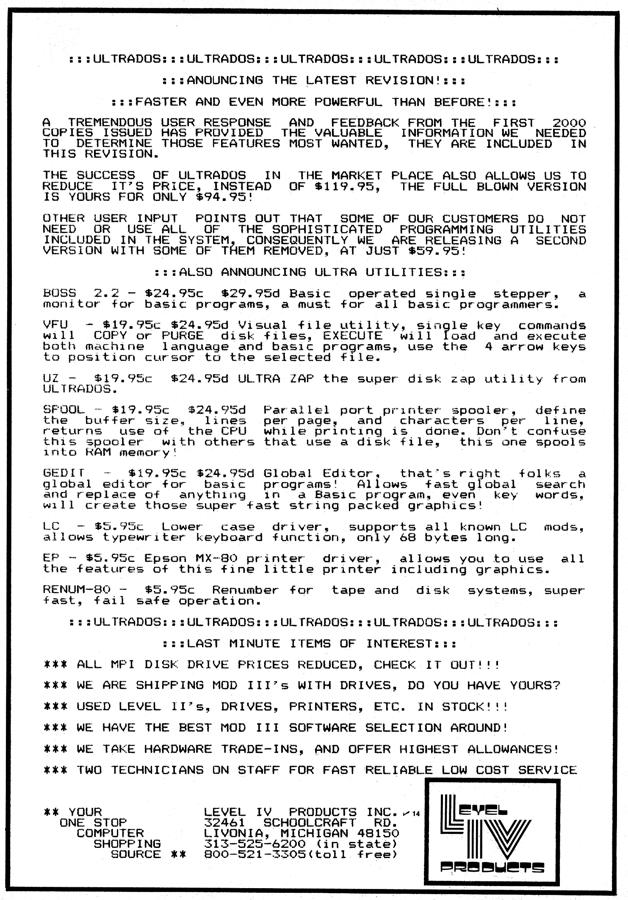









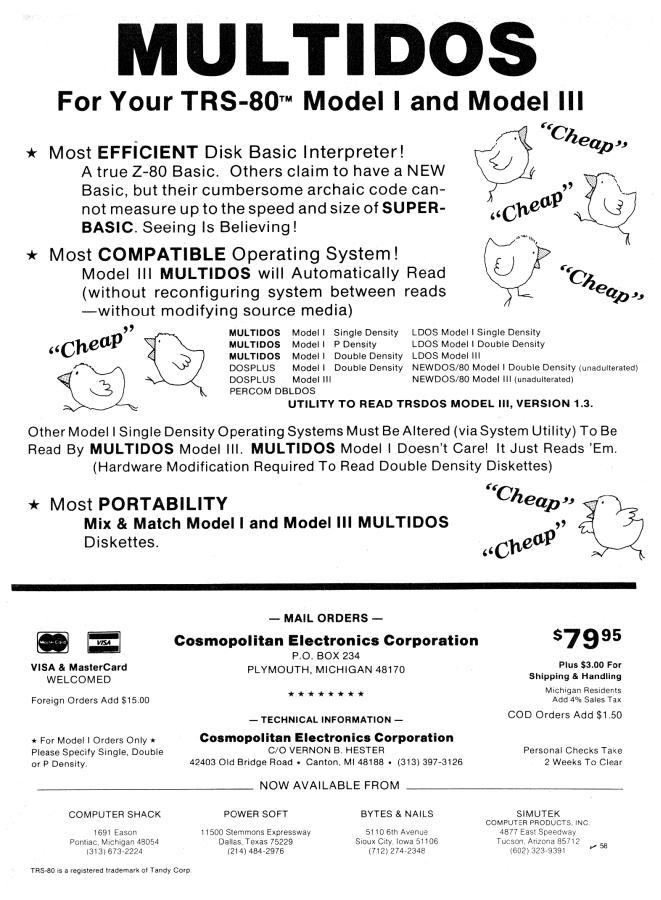
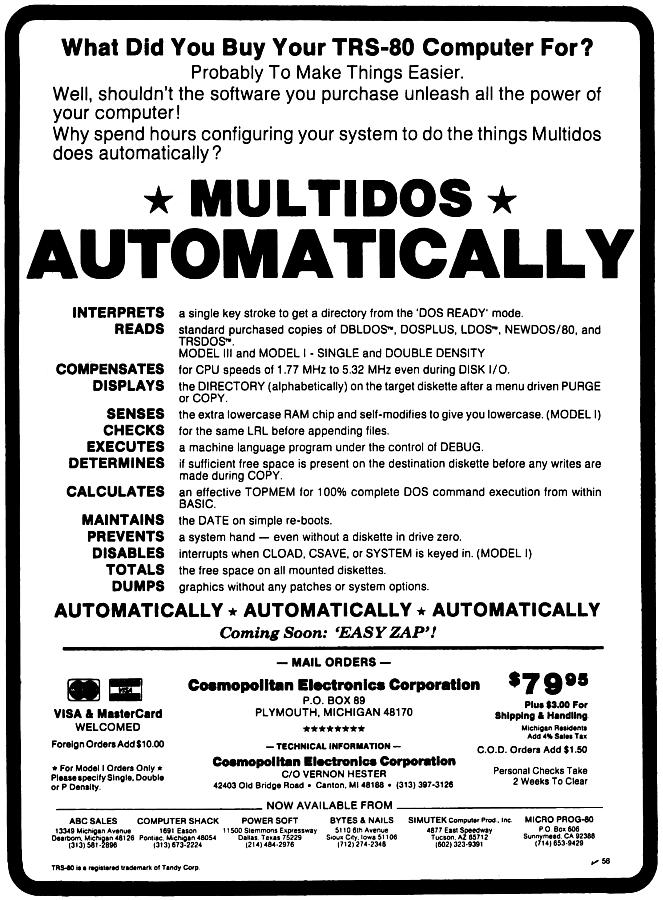

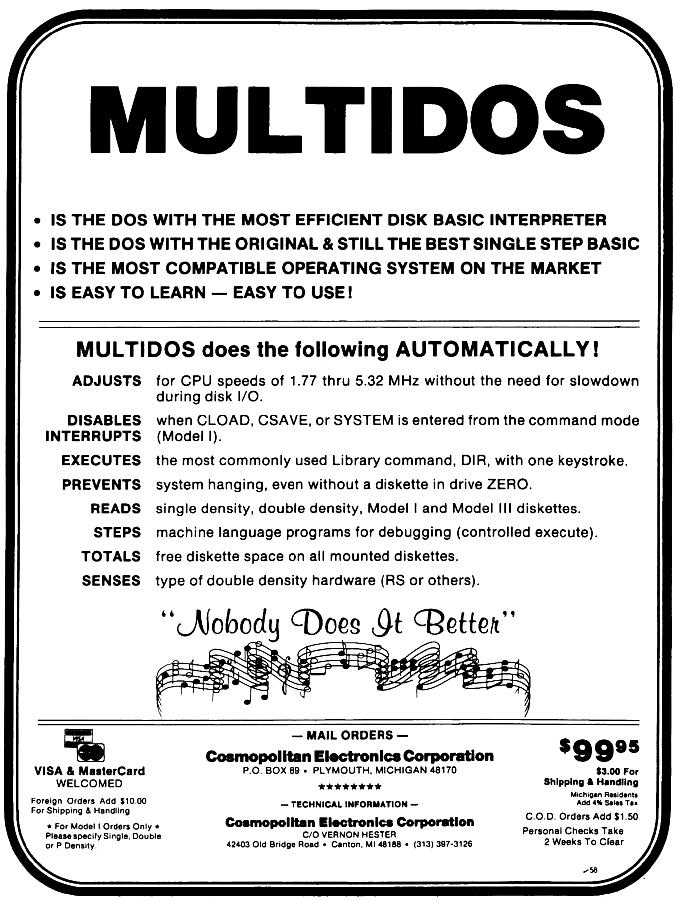
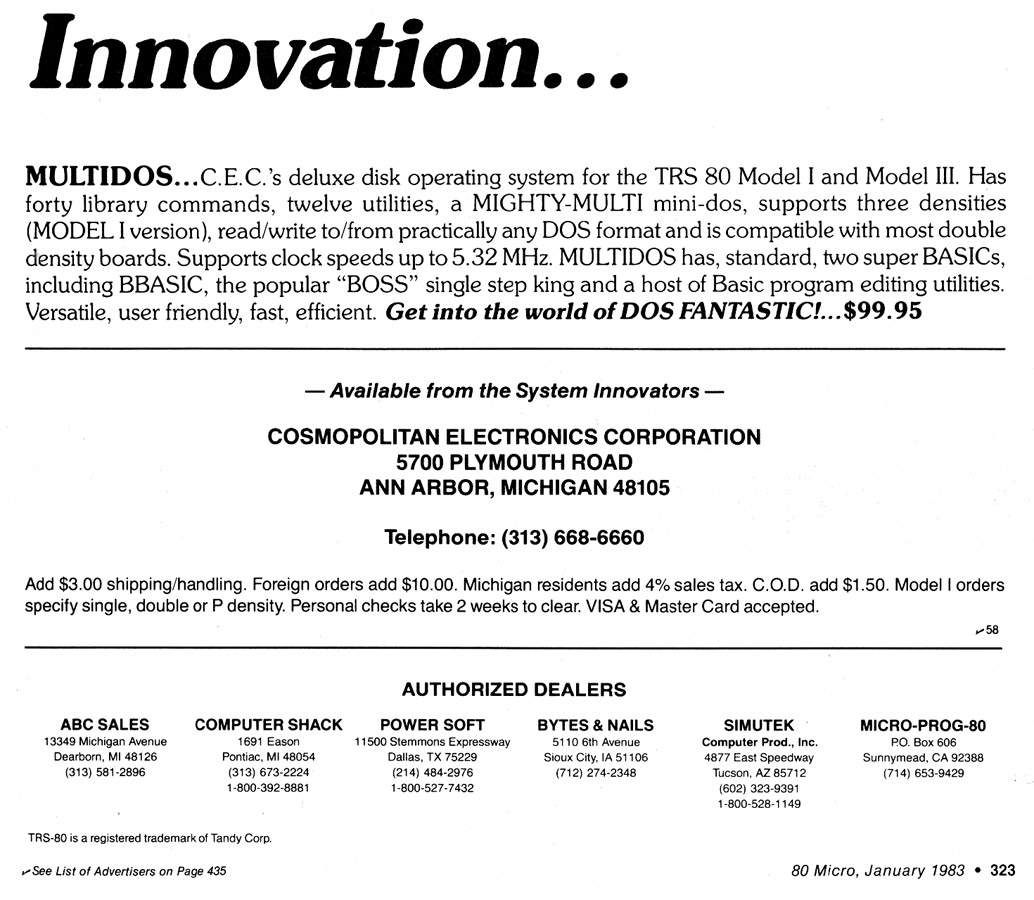

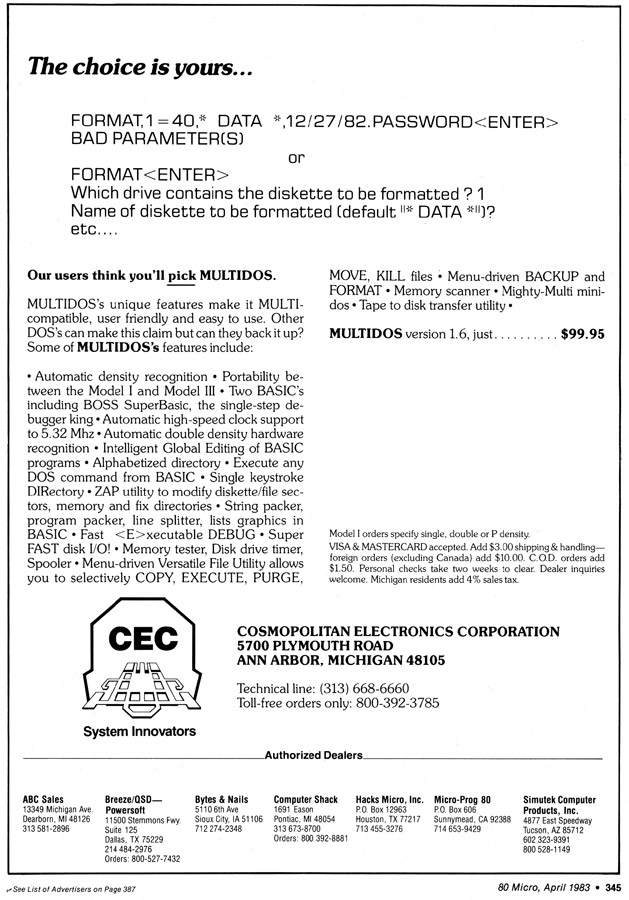
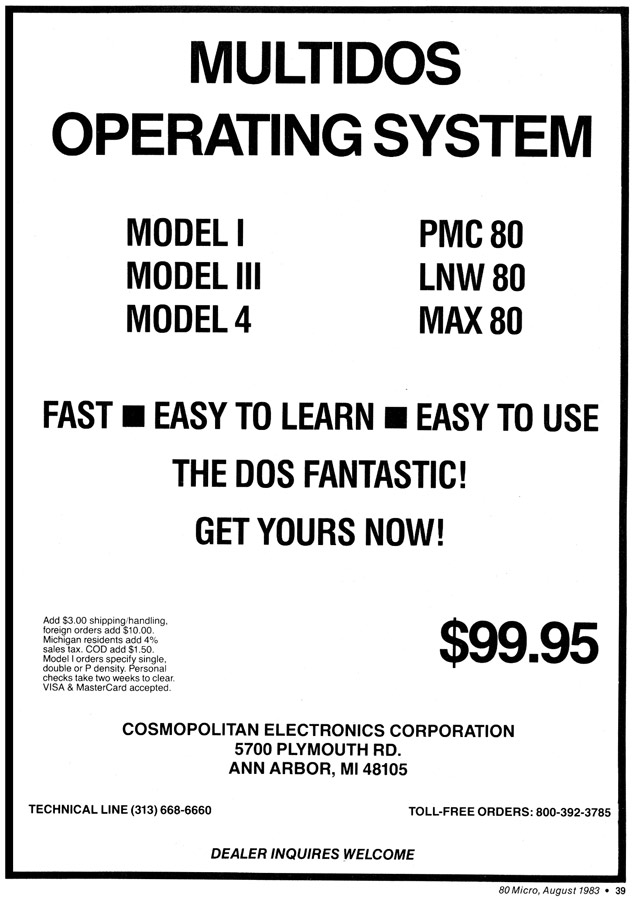



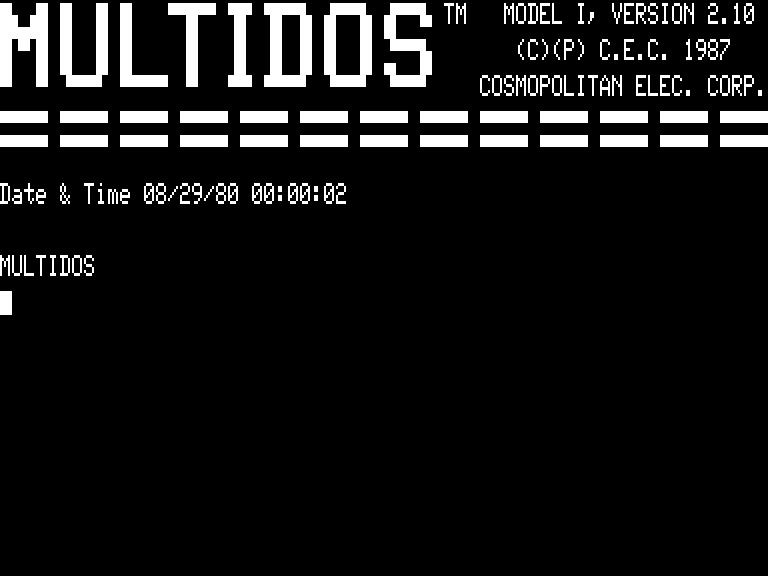
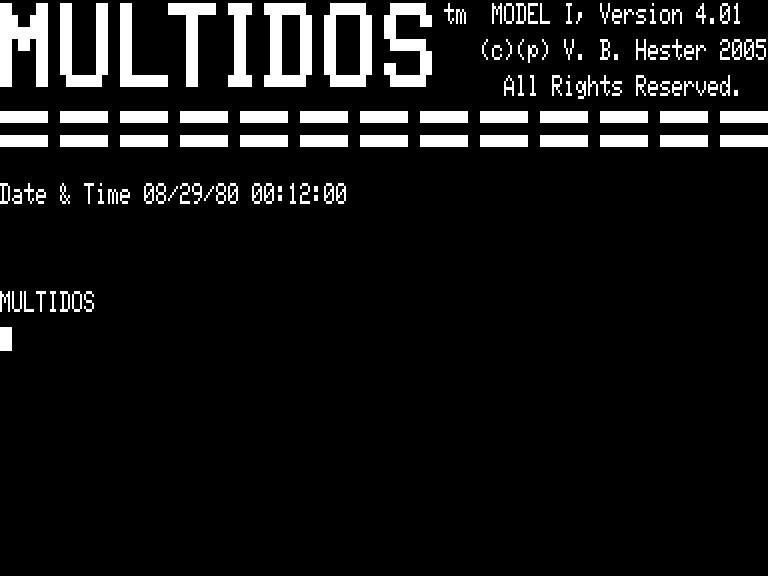
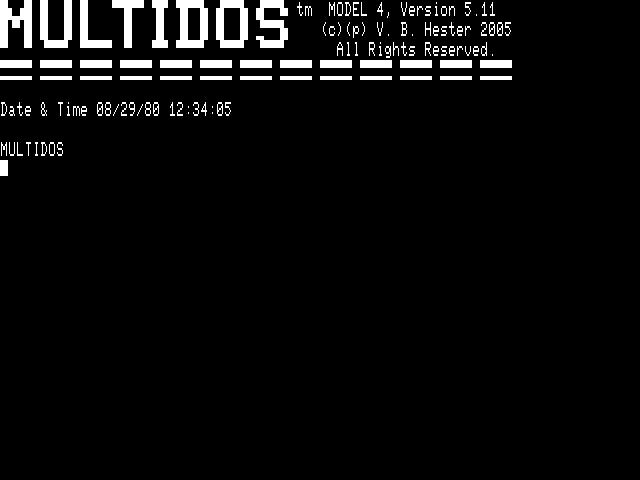
(Vernon-B-Hester).gif)
(Vernon-B-Hester).gif)
(Vernon-B-Hester).gif)
(Vernon-B-Hester).gif)

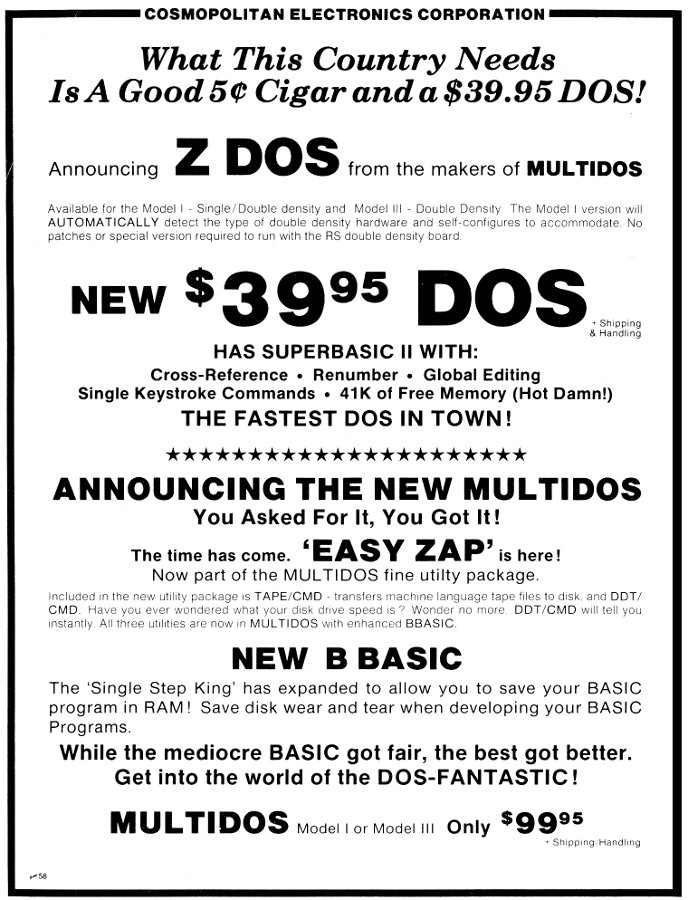
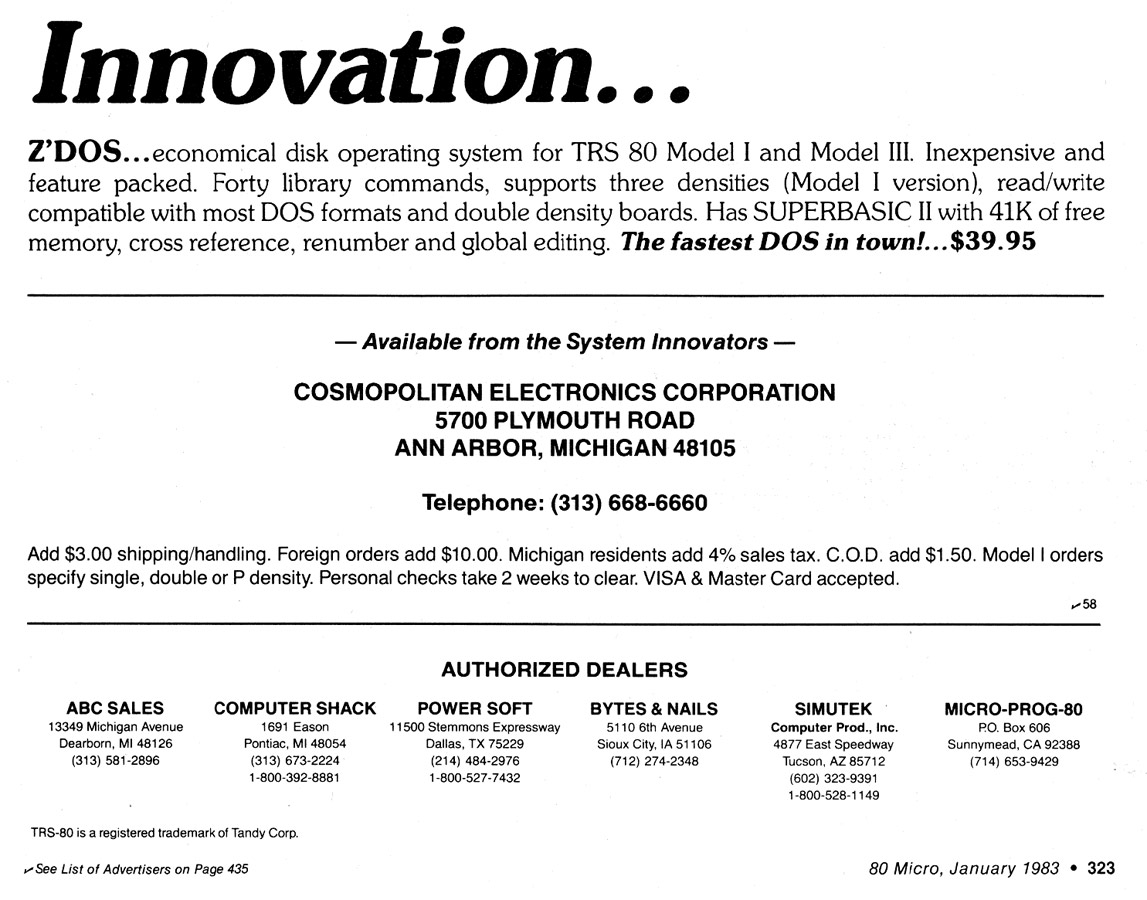
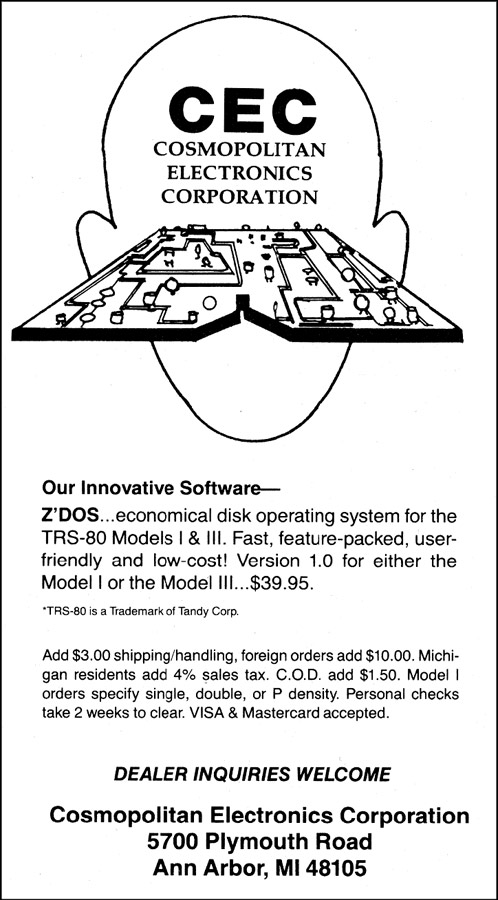
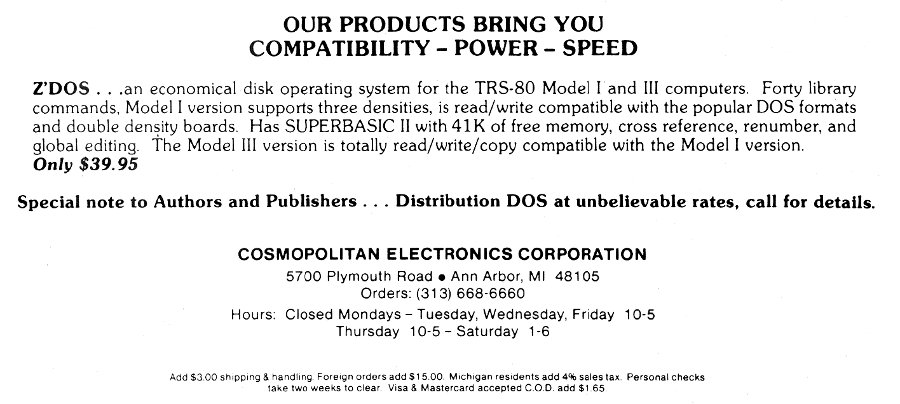
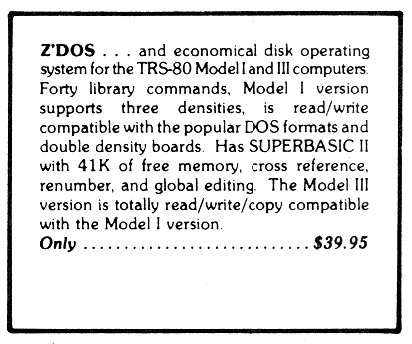



(Vernon-B-Hester)[M4].gif)
Regarding Astrocal, it’s a truly superb calculator/programmer. Emulating a Texas Instruments programmable calculator, it has extraordinary precision and range. With up to 119 significant figures and operating between 10^-9999 to 10^9999, it can compete with a mainframe and can calculate numerically with almost any precision and accuracy required, with many features (e.g. polar to Cartesian), conditional testing, etc.). I’ve used it to calculate gravitational orbits (better than Matlab), relativistic GPS clock corrections and probably anything you care to name. Just wish I had it running since 1991, I would have made much more progress towards that Nobel Prize. Well done, Vernon Hester!
Dear MULTIDOS users,
It would be great if MULTIDOS could be used as an operating system on the FreHD. AT the moment, LSDOS, LDOS and NEWDOS 80 are provided with this system, set yup by Hank Vercoven and retailed by Ian Mavric. I’ve currently placed an order for a Model I auto-bootable FreHD from Ian.
Has anyone (including particularly Vernon Hester) succeeded in setting up MULTIDOS for Models I, III and 4 for operation on FreHD.
I’m particularly keen for this capability, so that I can run the wonderful Astrocal SR52 emulator on the FreHD.
If so, please let Ian Mavric know, so the complete power of a TRS32 emulator on Windows running MULTIDOS with Astrocal can be made available more widely with the reliability of FreHD.